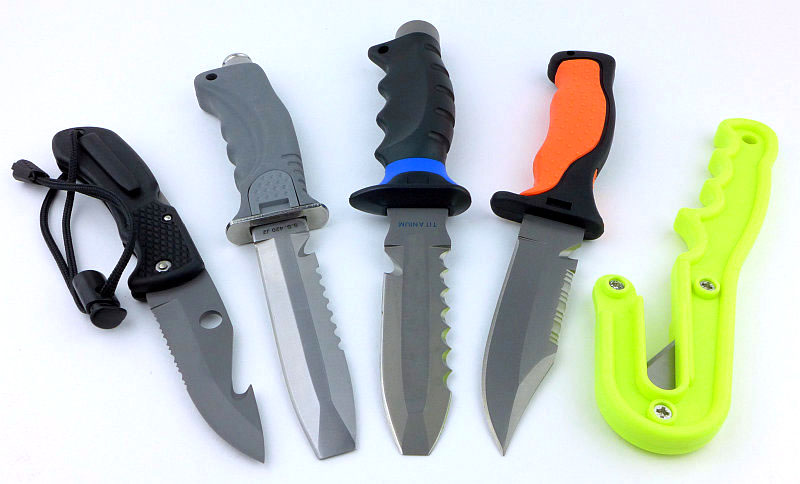This review provides further details for the five Promate dive knives (Barracuda Blunt Ti, KF593 Ti, KF090 Seal Folder Ti, KF505 Blunt and KF001 Line Cutter) which could not be included in the Dive Knives 2016 – Mega Test Review. Promate is a Full line manufacturer of scuba diving equipment and snorkeling gear including regulators, instruments, buoyancy compensators, masks, snorkels, fins, knives, boots, gloves and bags.
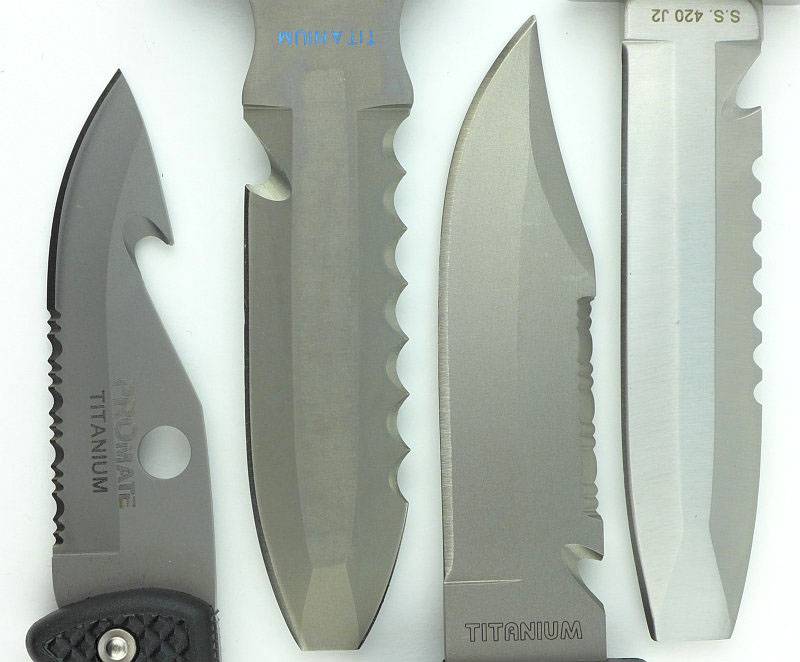
The Blade and Handle Geometry:
Most knife specifications have a basic description of the blade geometry, but in this section I will be taking a more detailed look at geometry and balance.
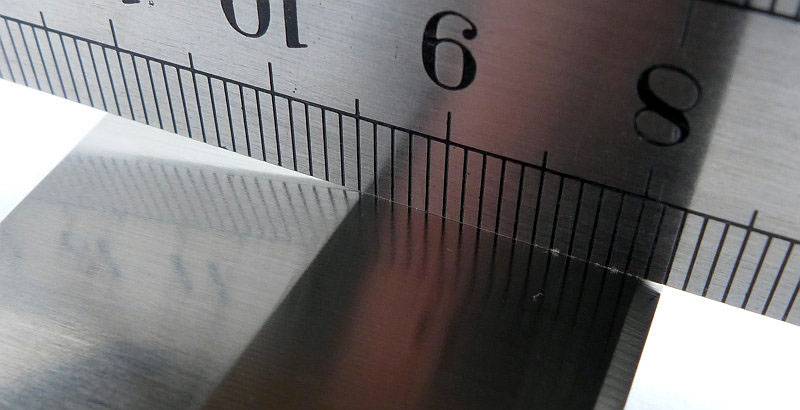
Using a set of gauges and precision measuring equipment including a Vernier protractor, callipers, fixed radius gauges and the unique Arc Master adjustable radius gauge (the one that looks like a crossbow).
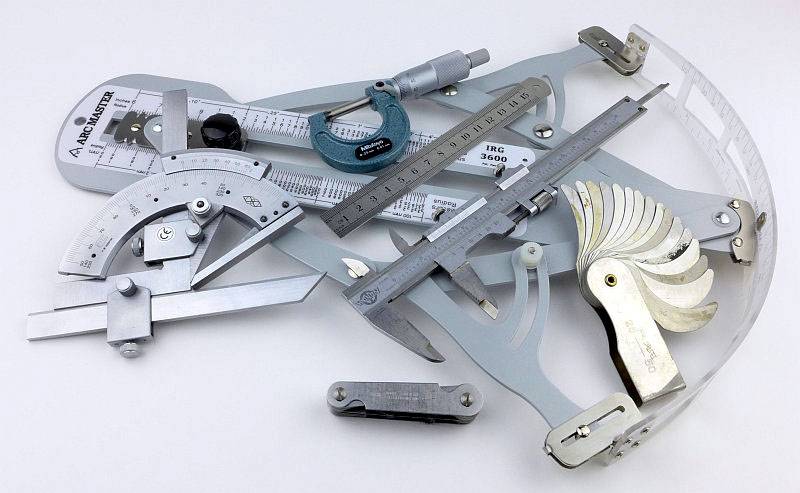
These measurements have been tabulated and are presented along with other blades.
Key aspects such as the primary bevel angle, grind type, blade depth, blade thickness, length, weight are detailed, along with balance information.
The ‘Balance relative to the front of the handle’ tells you if the knife will feel front heavy, or if the weight is in your hand (a positive value means the weight is forward of the front of the handle). The ‘Balance relative to the centre of the handle’ indicates how close to a ‘neutral balance’ the knife has in the hand.
In the case of full convex grinds the approximate centre of the grind is used for the primary bevel angle estimate.
The measurements are presented alongside some of the other knives from the Dive Knives 2016 – Mega Test Review
As there are five Promate cutting tools, these are logged across two tables.
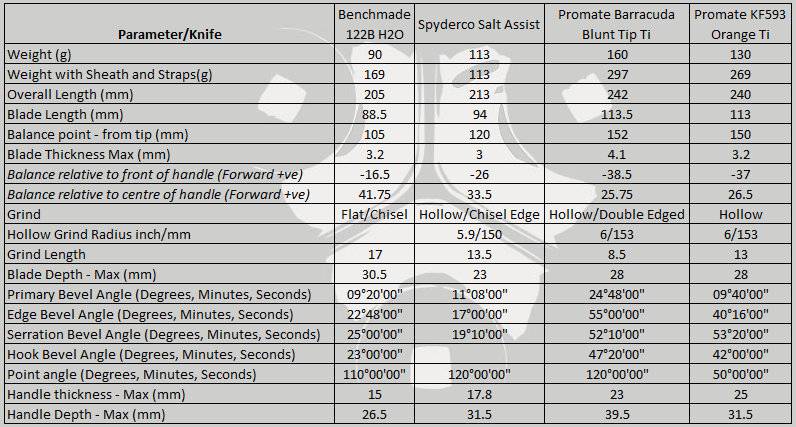
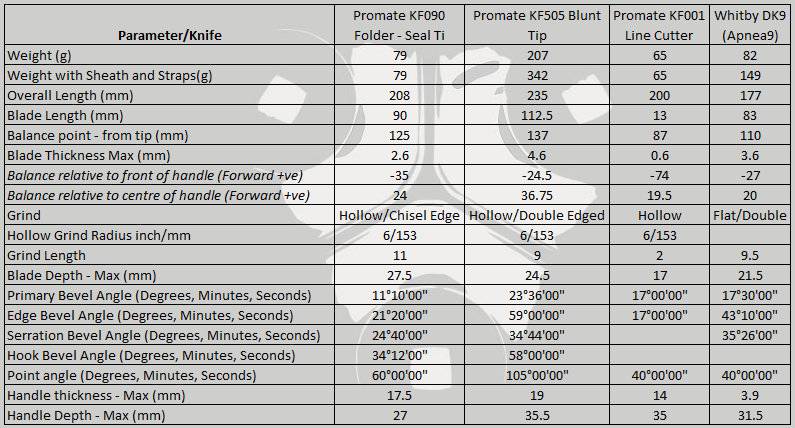
A few more details of the KF001 Line Cutter:
There are five models from Promate and a huge amount of detail to cover, so each one will have its own “A few more details…” section.
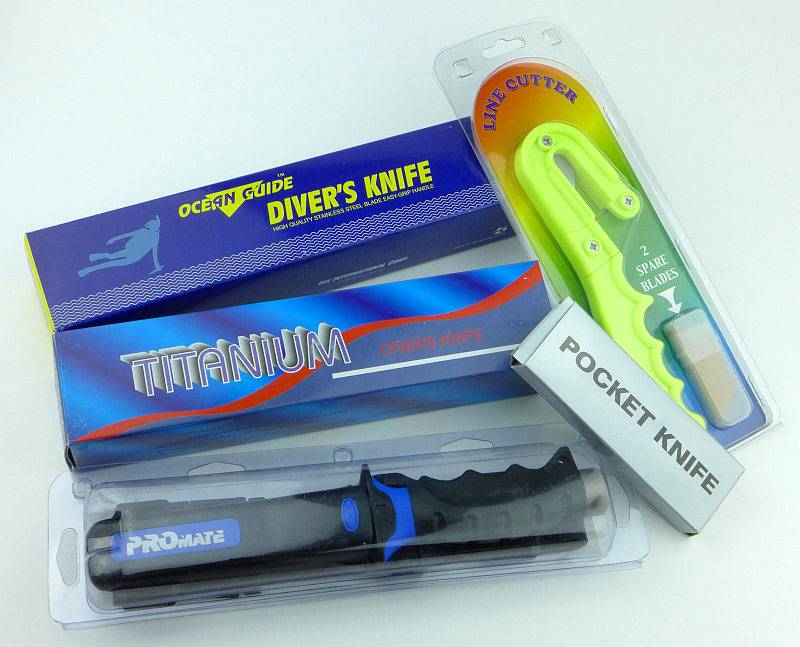
The first two we will look at are the ones that are not fixed blade sheath knives, the Seal Folder and Line Cutter.
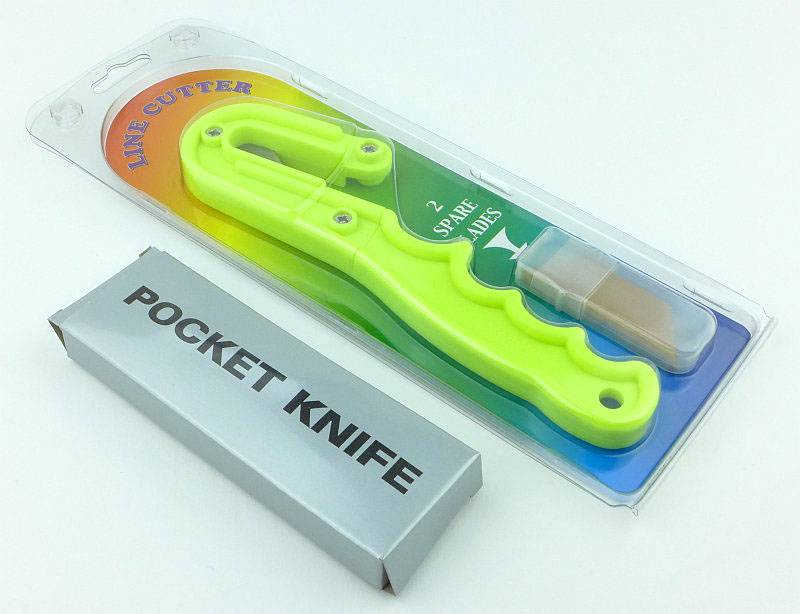
Fresh out of the box.

A small container is supplied with the line cutter.
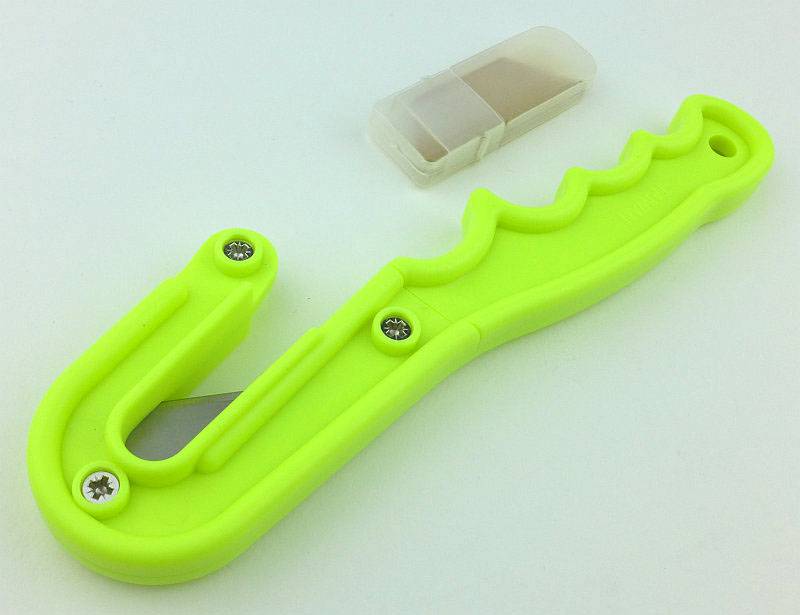
This contains two spare blades wrapped in oil paper.
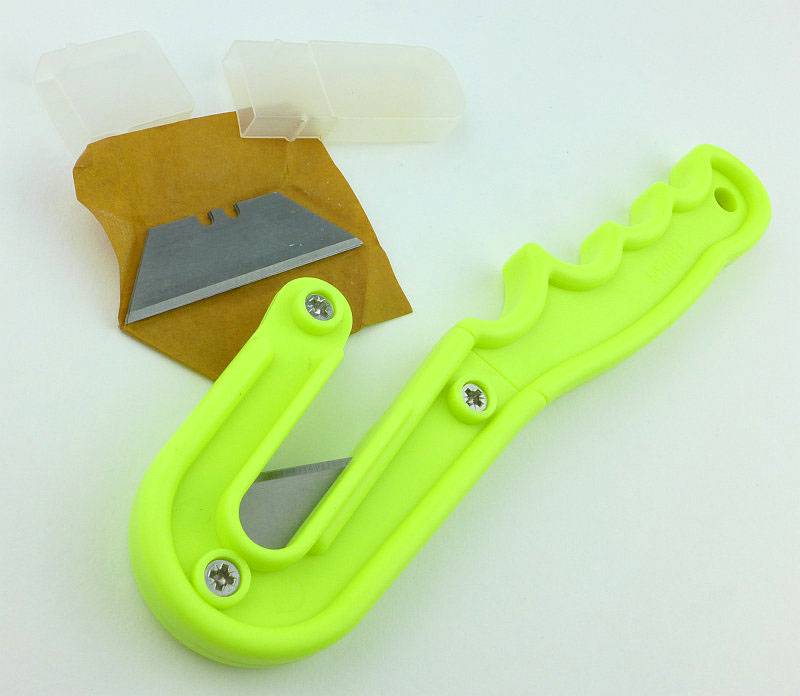
A close up of the blade in the line cutter.
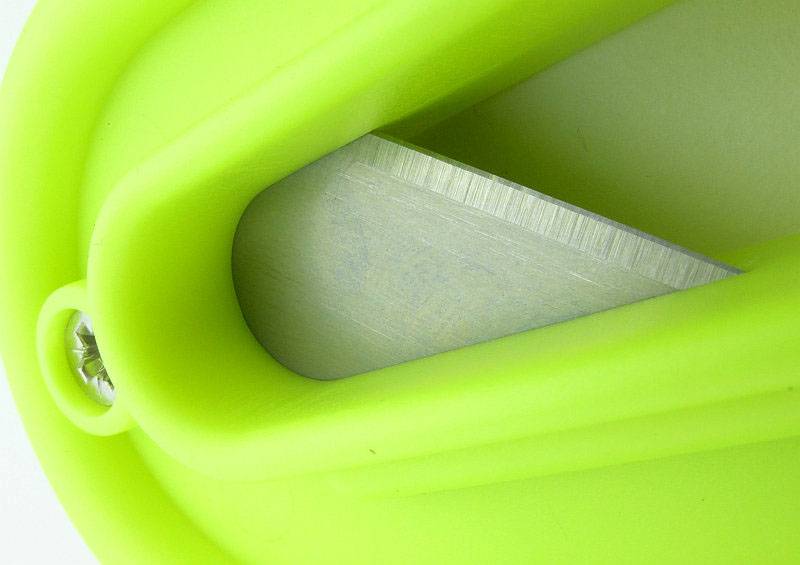
Taking out the three screws holding the line cutter together allows you to see how the standard utility blade fits inside.
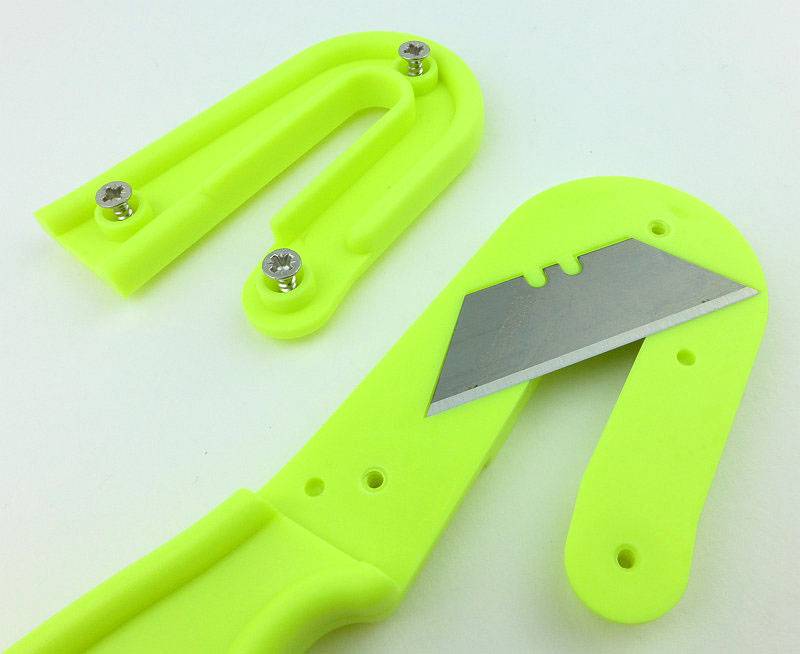
It is a generous size so is easy to handle.
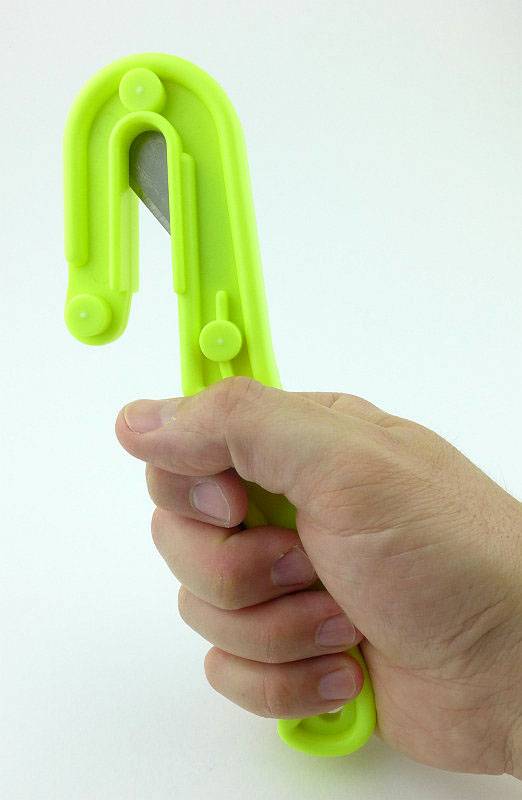
A few more details of the KF090 Seal Folder Ti:
An adjustable wrist strap is supplied fitted to the Seal folder.
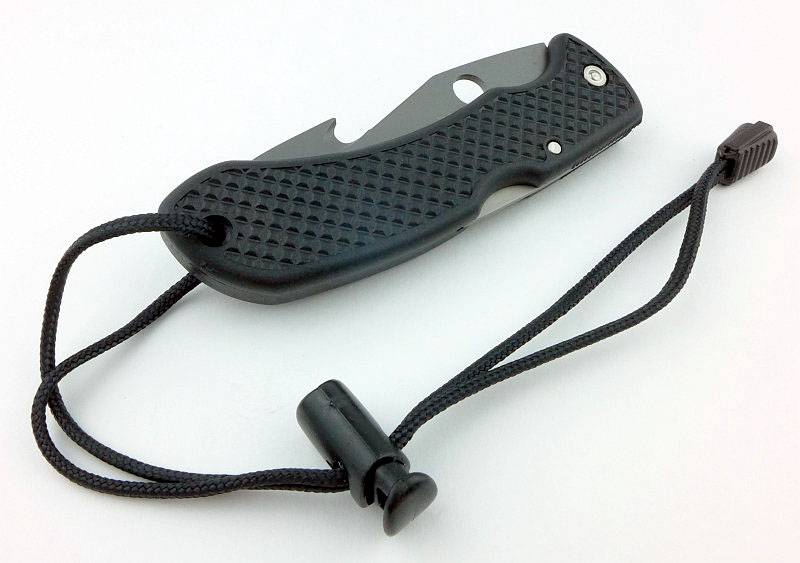
The pivot is riveted and cannot be adjusted.
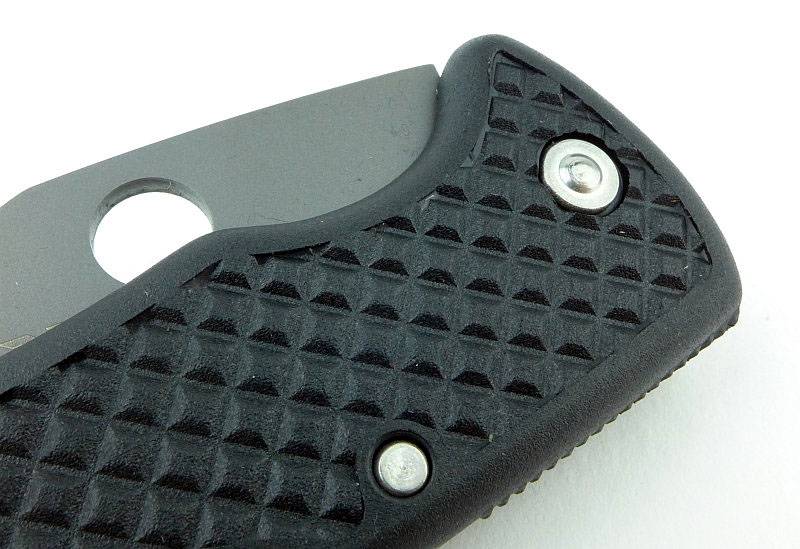
On one side there is a plastic pocket clip.
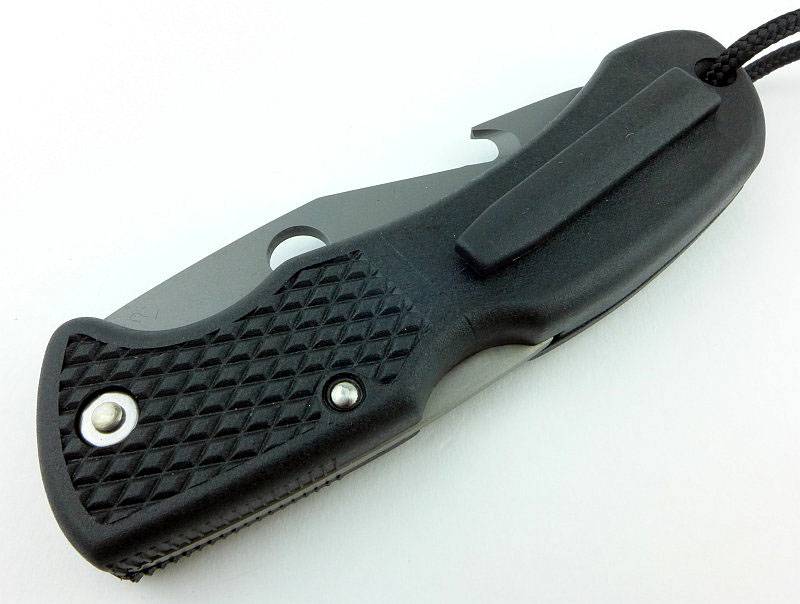
From this side you can see the blade pivot and lock bar pivot rivet heads.
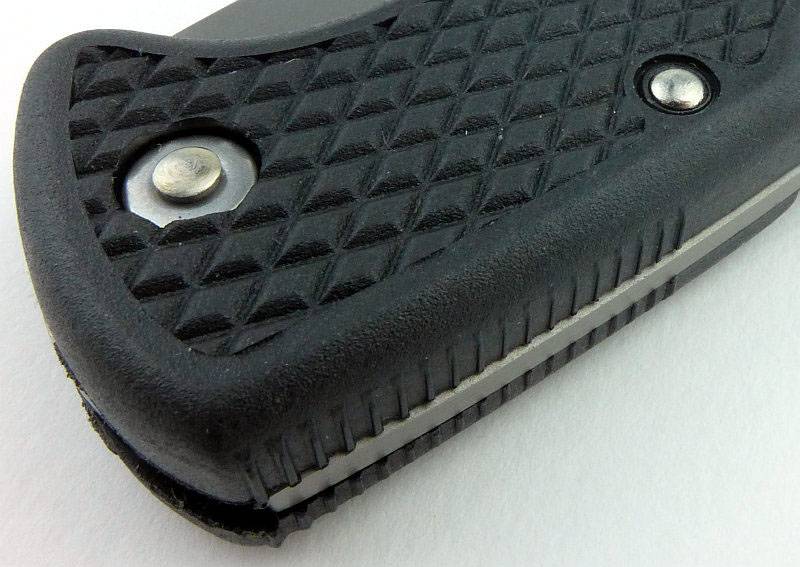
As a specialist knife, the Seal folder has an unusual cutting hook which is accessible even with the blade folded.
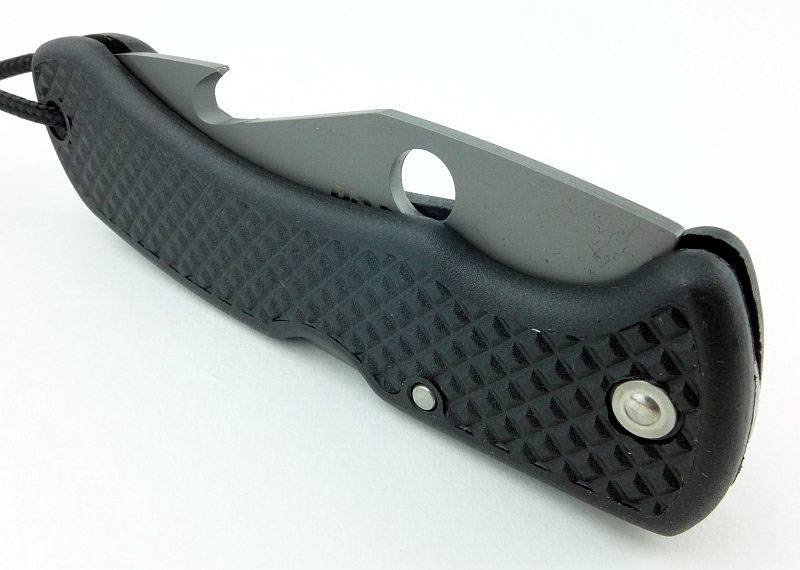
A closer look at the cutting hook.
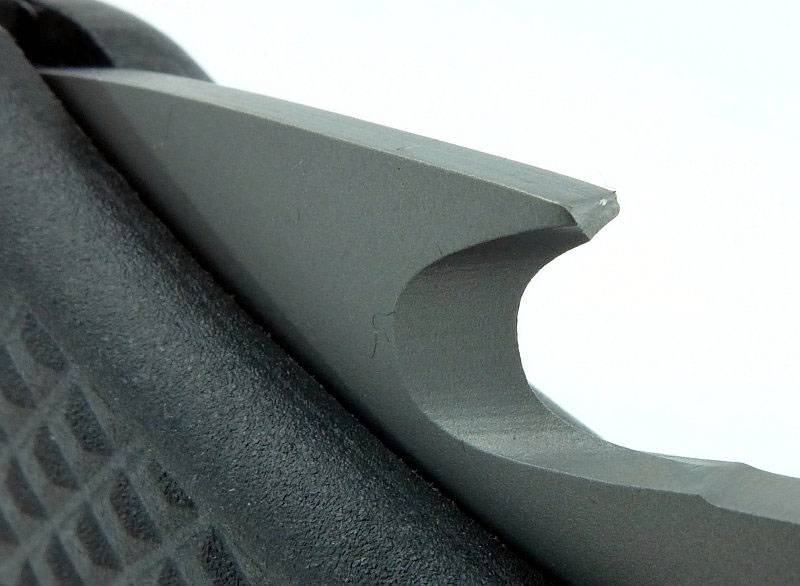
The blade is part serrated and there is a small thumb opening hole.
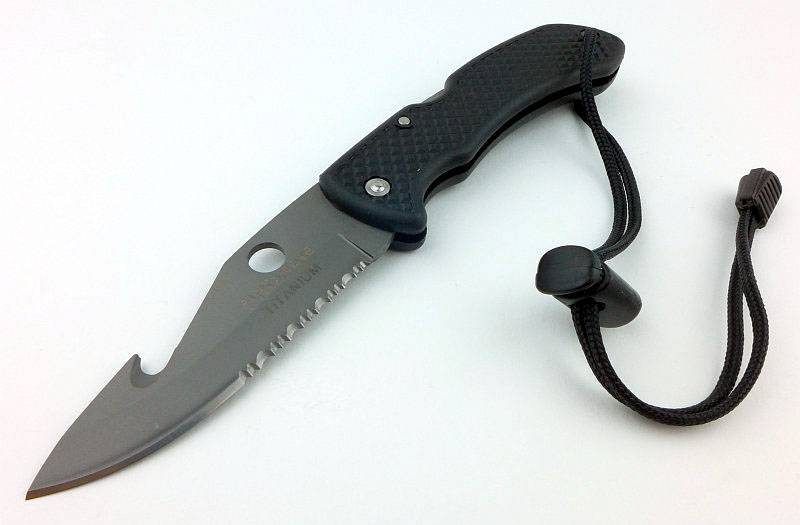
In case you had forgotten, it is made of titanium. The serrations are well formed.
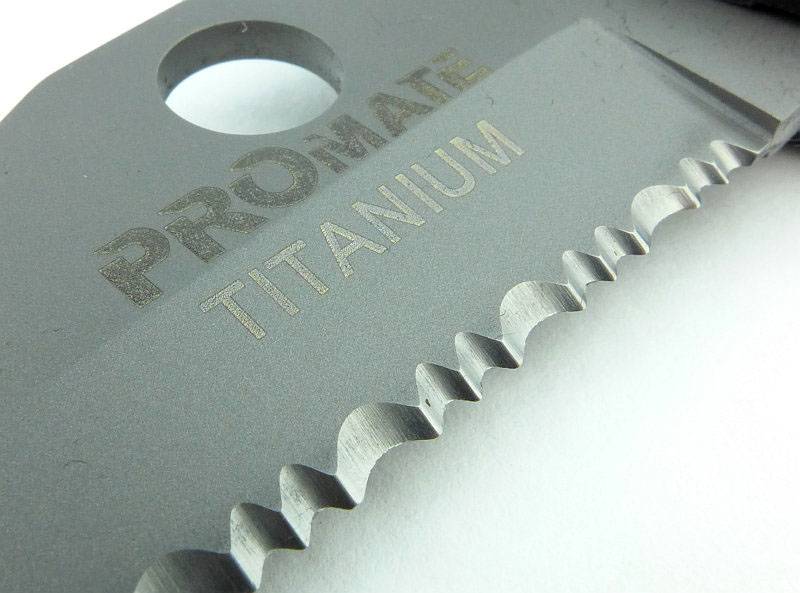
When you look at the reverse of the blade, you can see that this knife uses only a single bevel edge.
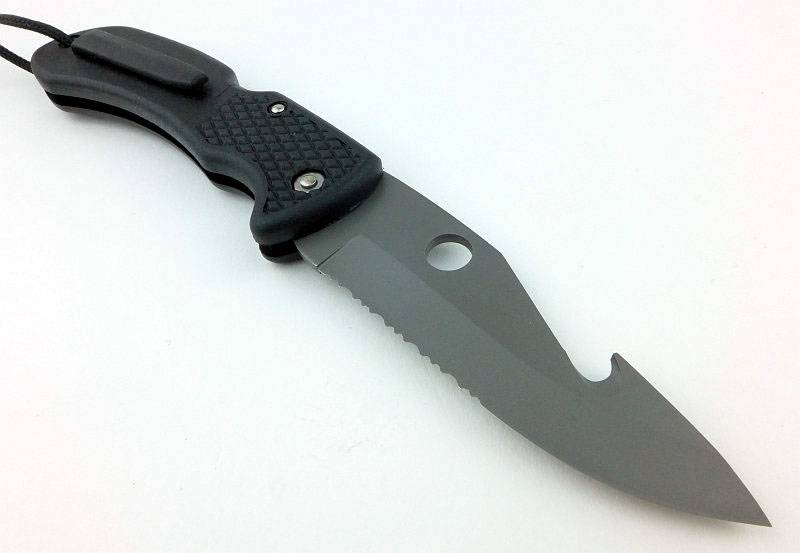
Going in closer to the back of the serrations.
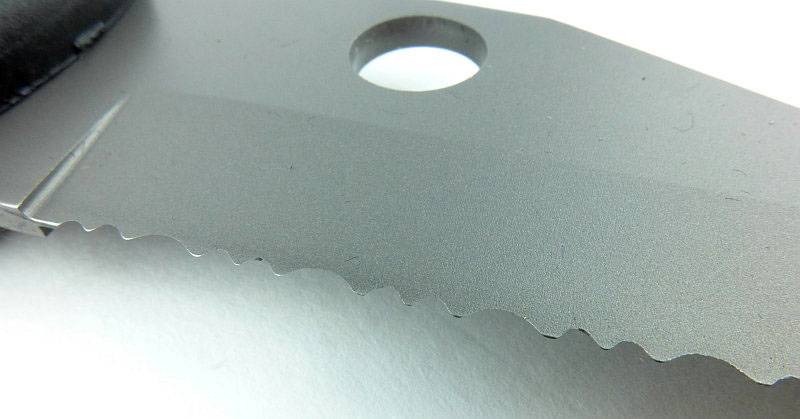
And also the plain edge.
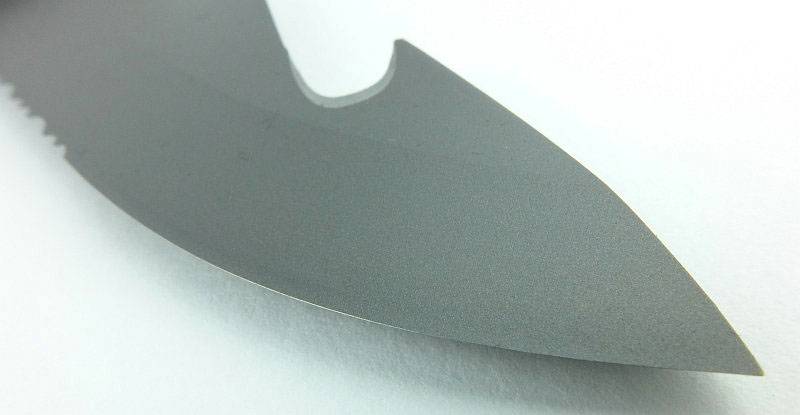
Not a large knife, the Seal folder is still a comfortable size.

A few more details of the Barracuda Blunt Ti:
Promate’s Barracuda comes in Steel and Titanium versions, as well as blunt and pointed tips. The fully diving orientated blade design with Titanium and a blunt tip was chosen for the review.
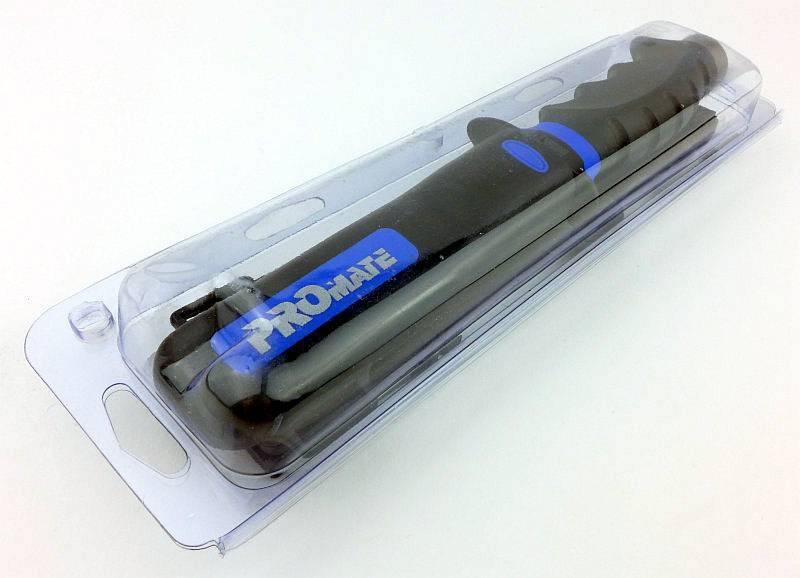
Supplied with the knife are two rubber straps and an instruction leaflet.
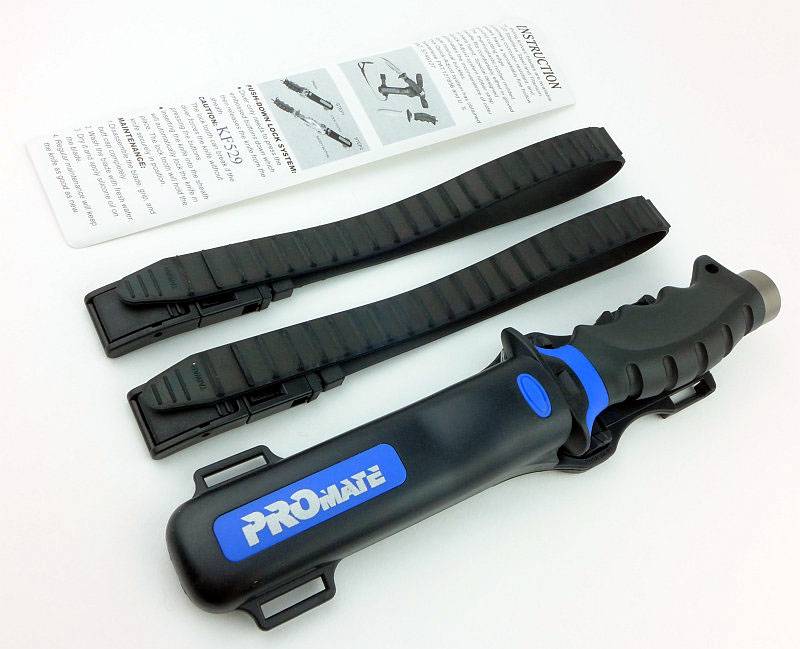
The strap has quick release buckles.
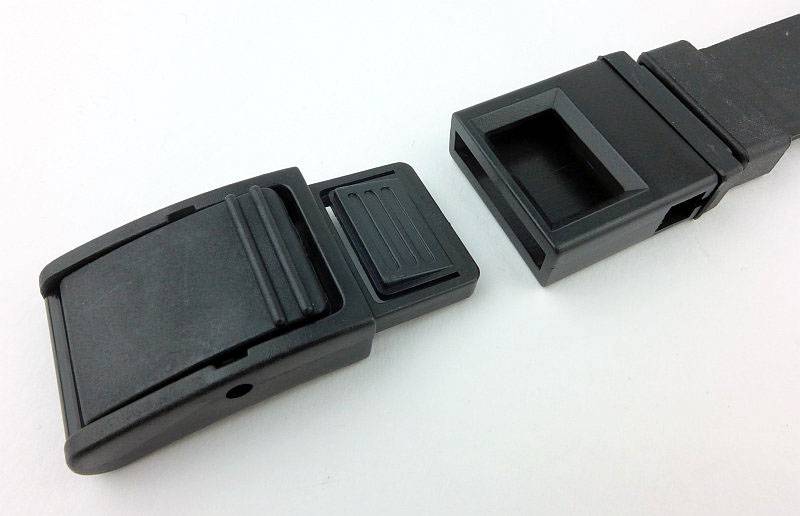
Each buckle has a sprung loaded adjustment clip to grip the rubber strap.
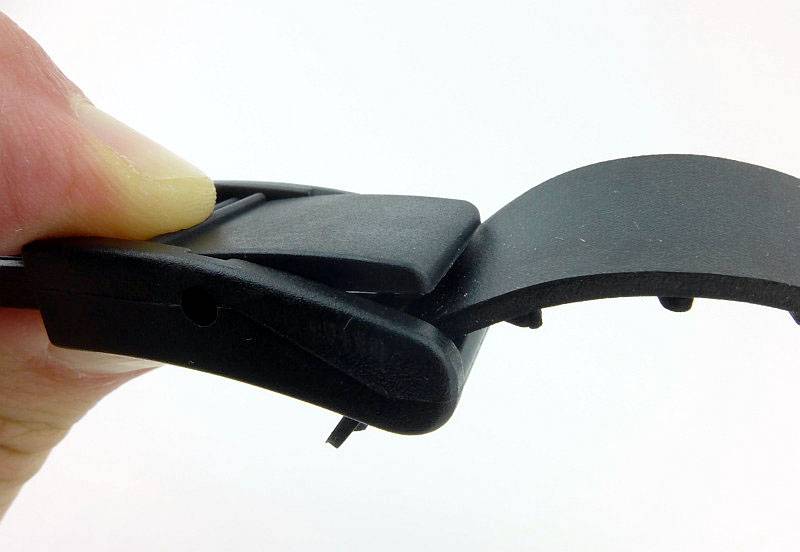
A strap in its fully assembled state. However this now cannot be fitted to the sheath. You need to take it apart, thread it through the slots and then reassemble it.
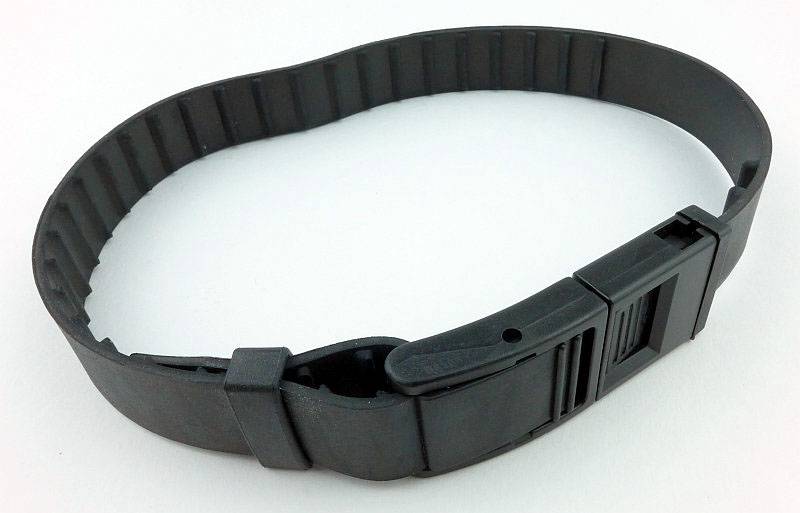
Before unsheathing the knife for the first time.
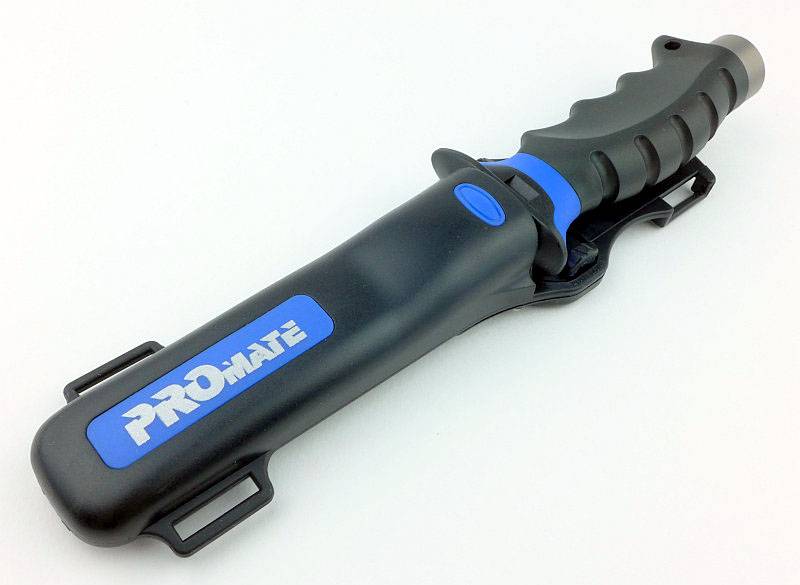
Inside the sheath the blade is wrapped in plastic.
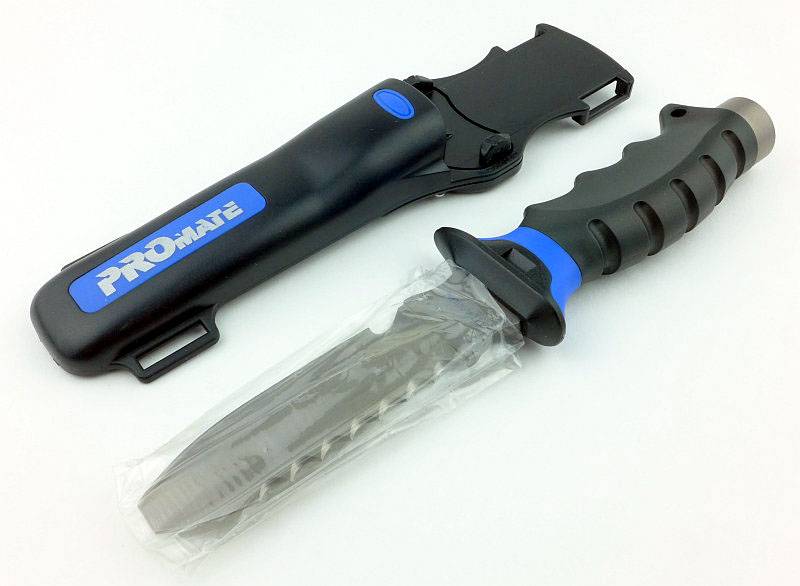
With the knife out, you can see the ambidextrous retention clip.
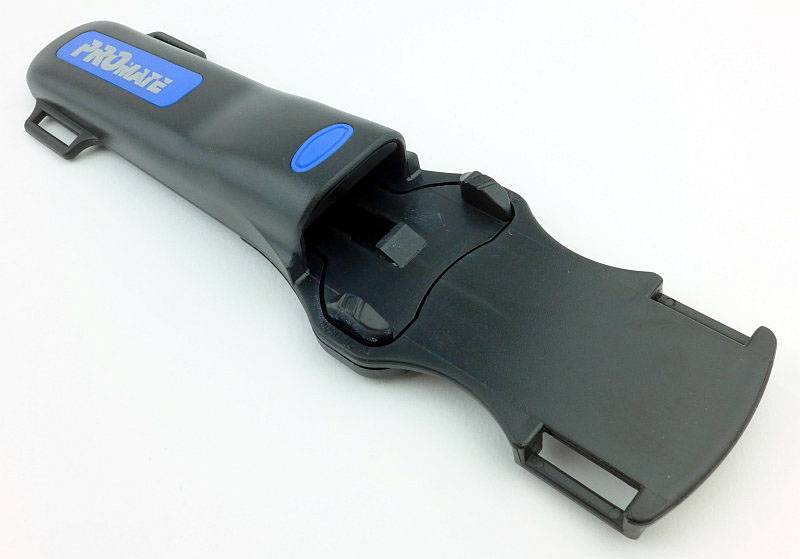
The retention clip is a sprung plate with a catch in the centre and a release button each side.
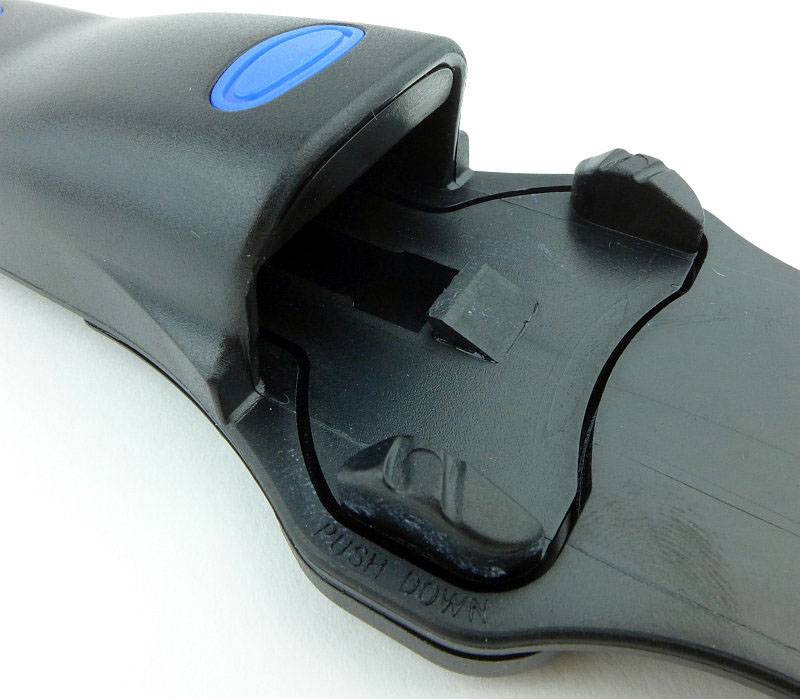
A quick look at the back of the sheath.
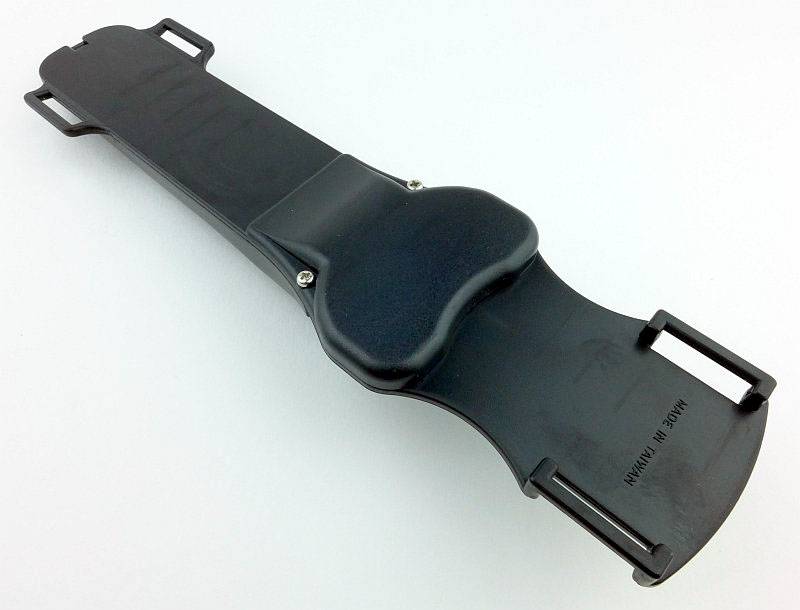
A fully featured blade made of titanium which has a cutting hook, plain edge, prying blunt tip, smaller plain edge leading into a section of large serrations.
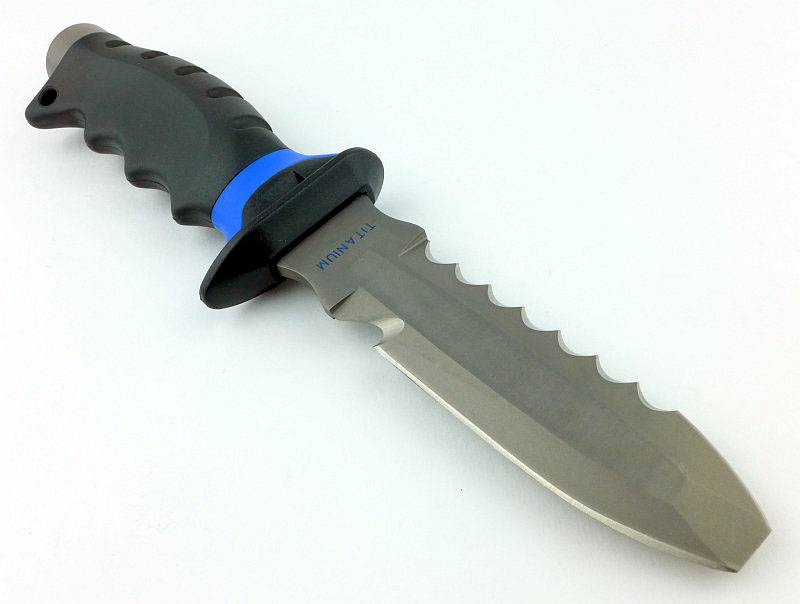
Clearly marked as being made of titanium.
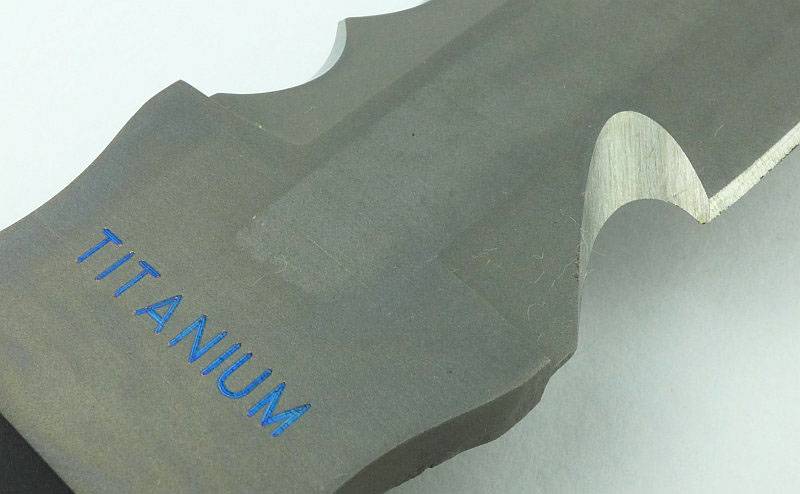
A cutting hook is included near the handle.
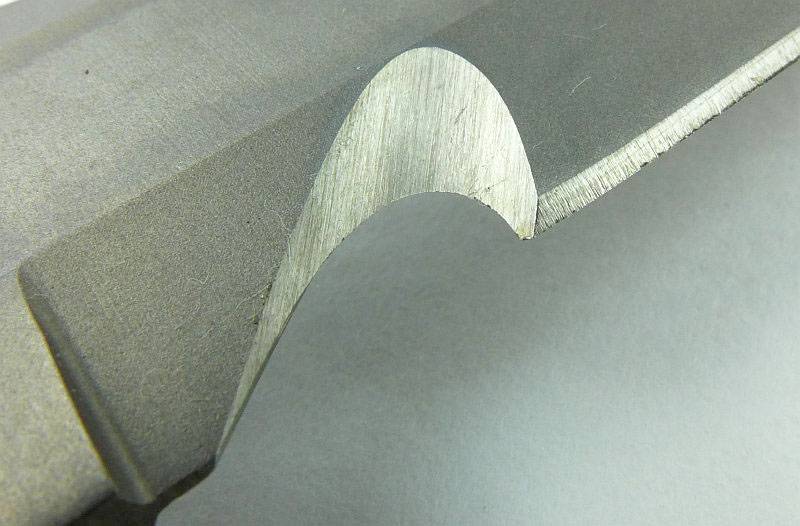
The blunt tip is shaped nicely for prying, tapered but not too thin at the end.
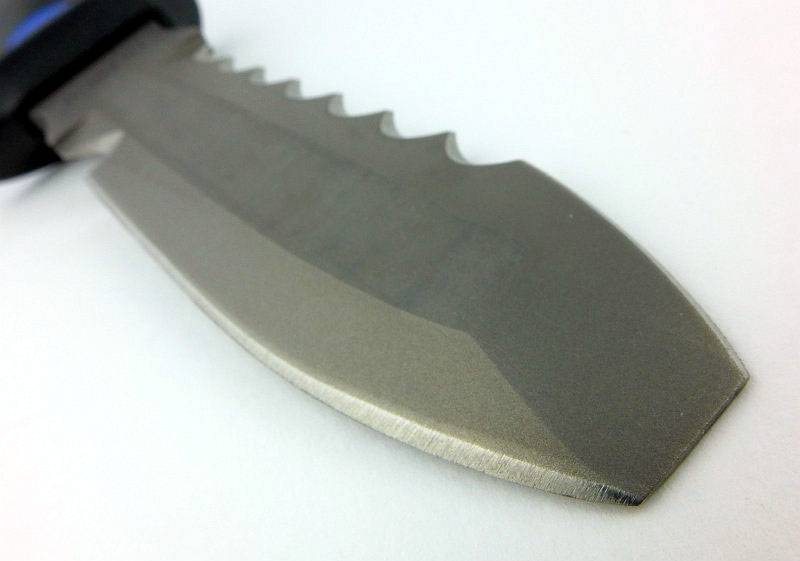
Contoured more heavily than any of the other handles, the Barracuda provides excellent grip in all conditions.
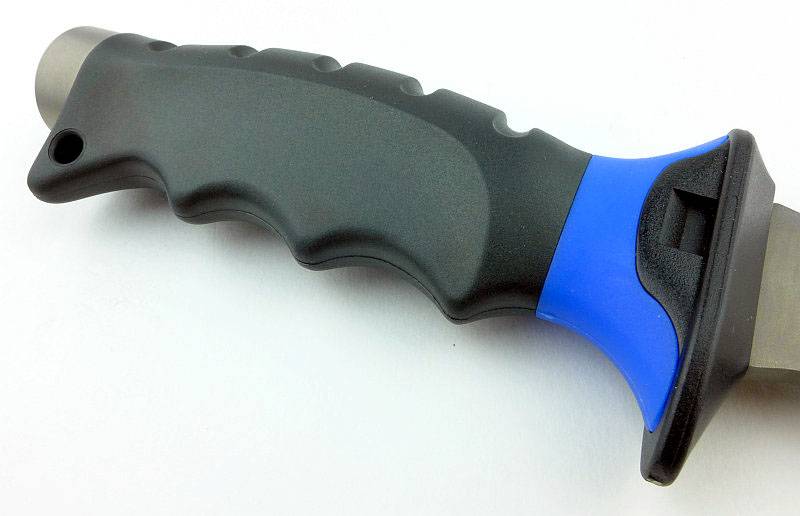
Just at the guard area is the indentation that the retention clip holds on to.
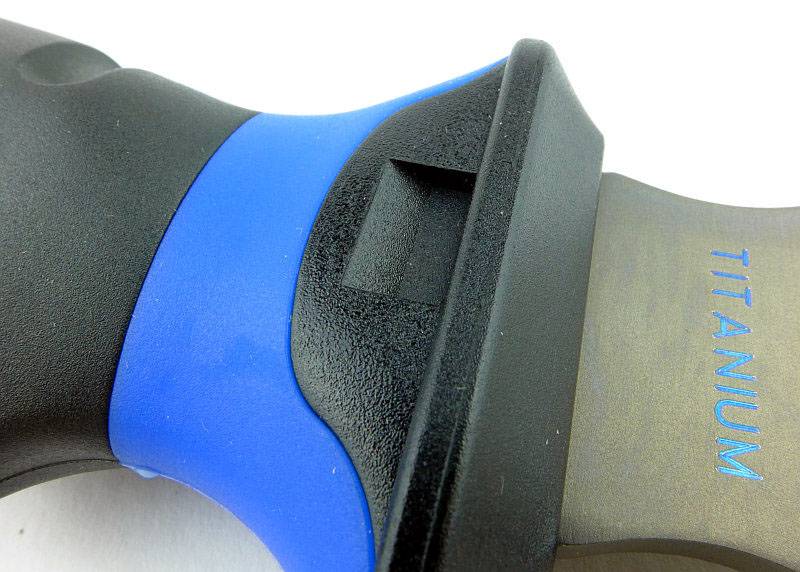
The back of the blade reveals that the serrations are cut with a single bevel, but the plain edges are double bevelled.
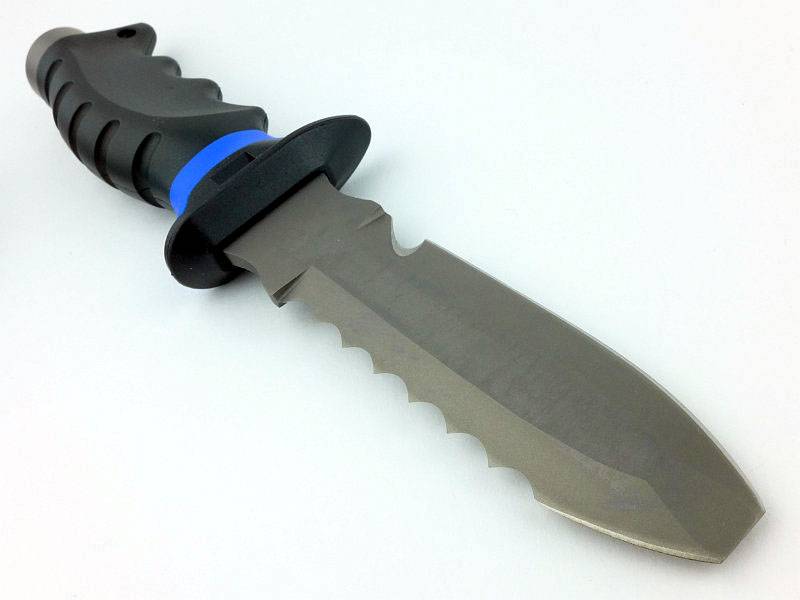
Nicely cut, the serrations are larger than any others I’ve used.
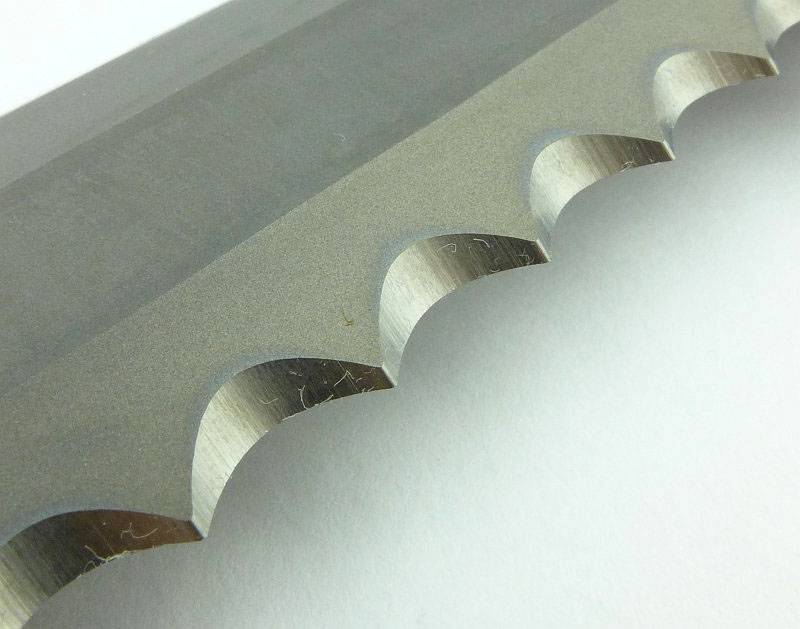
For scale, I take XL size gloves.
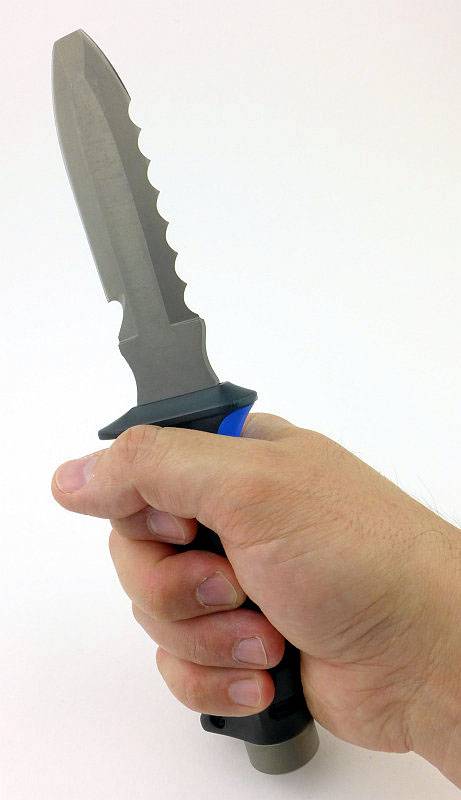
The butt has a large hammer striking surface. This is made of Titanium, so is not up to very heavy work.
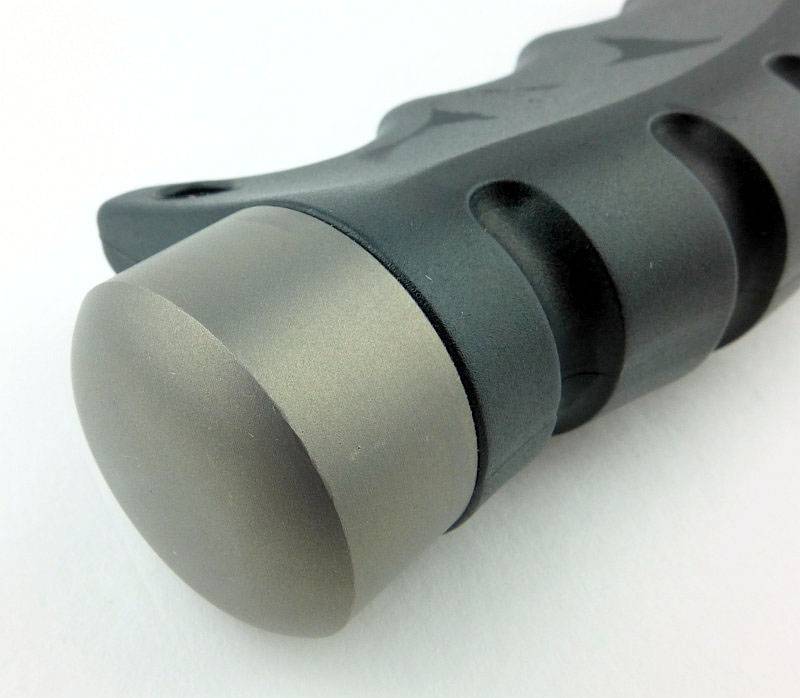
Though it doesn’t need any cleaning for corrosion prevention, the Barracuda does fully disassemble.
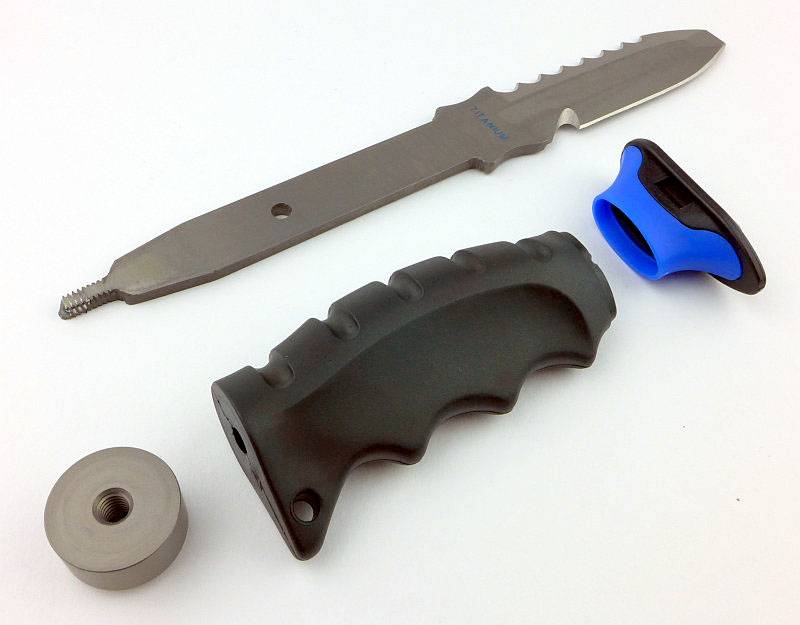
As mentioned earlier, the straps need to be threaded through the loops before fitting the quick release buckles.
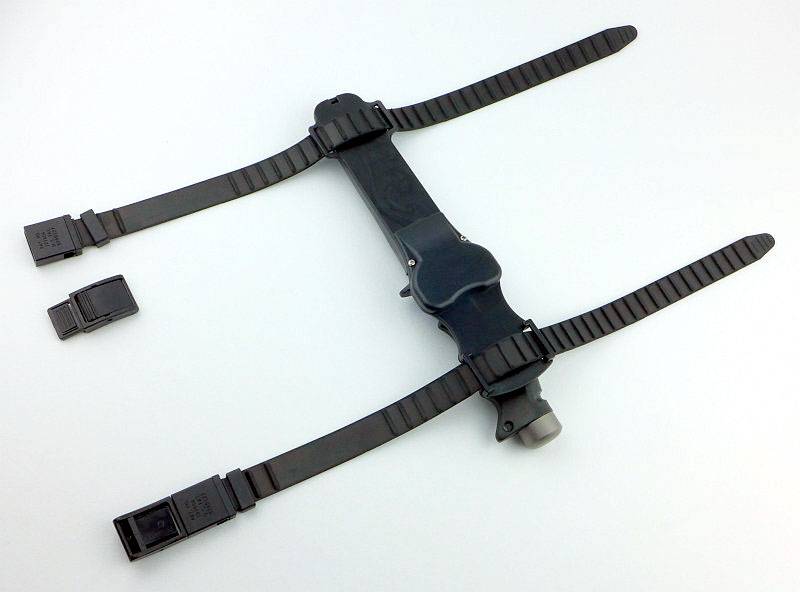
Fully assembled and ready for work.
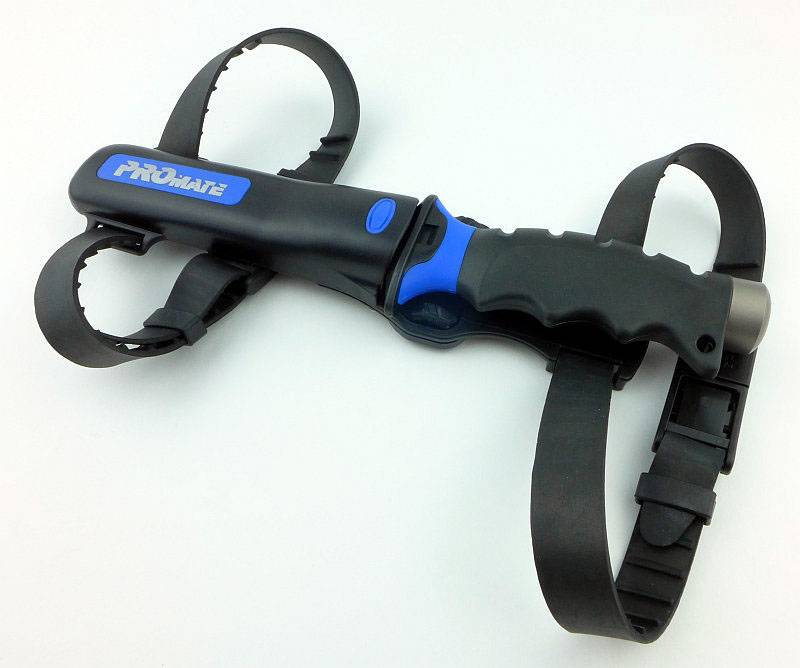
A few more details of the KF593 Ti:
This is a knife which has had a little more exposure than most and you might recognise it as it was featured in a few episodes of Bear Grylls ‘Man vs Wild’. It is also known unofficially as the Promate ‘Scuba’ Knife, but officially only as the KF593. There is a blunt tip version as well.
The KF593’s box.
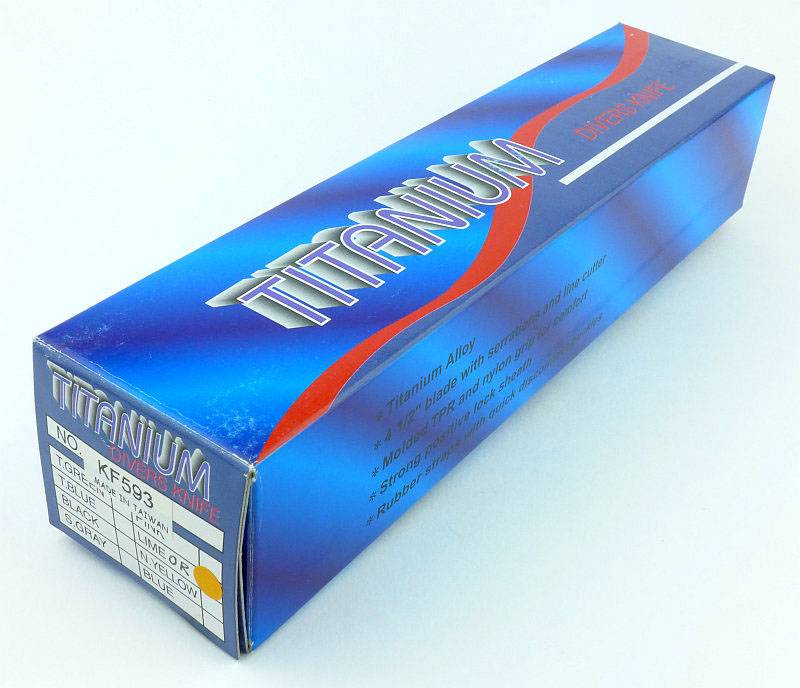
Inside the box the knife comes wrapped in plastic. Also include are two rubber straps.
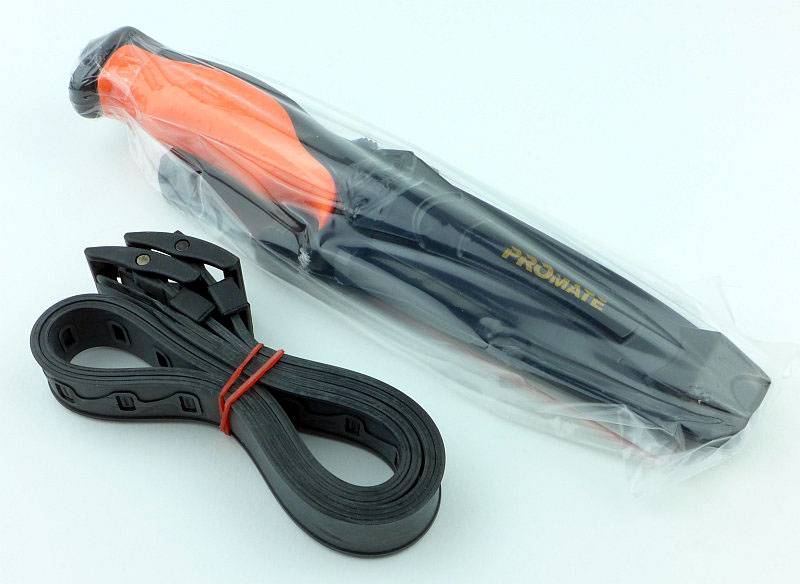
With the wrapping off. There is a warning card included regarding care for the knife, however, this advice proved unnecessary.
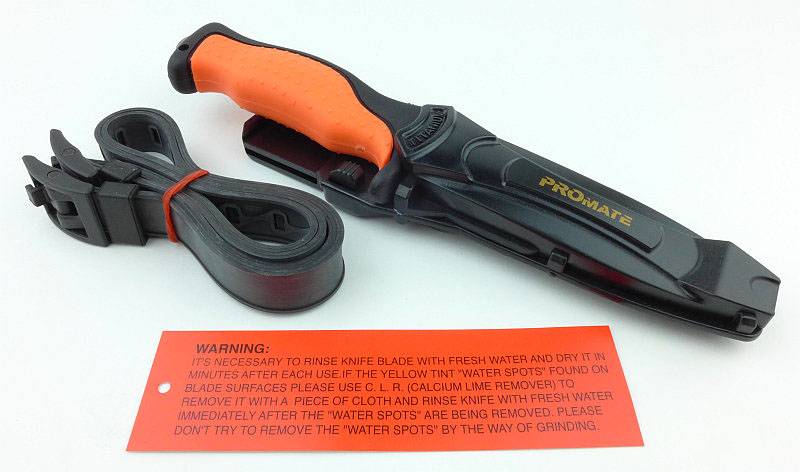
The KF593 fresh out of the box.
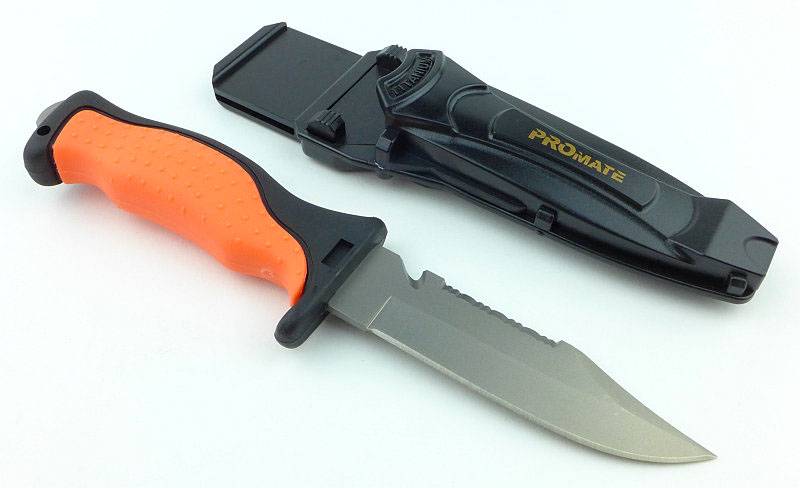
One of the great features of the KF593 is the retention system of the sheath. There is a sprung plate with two release buttons and a catch.
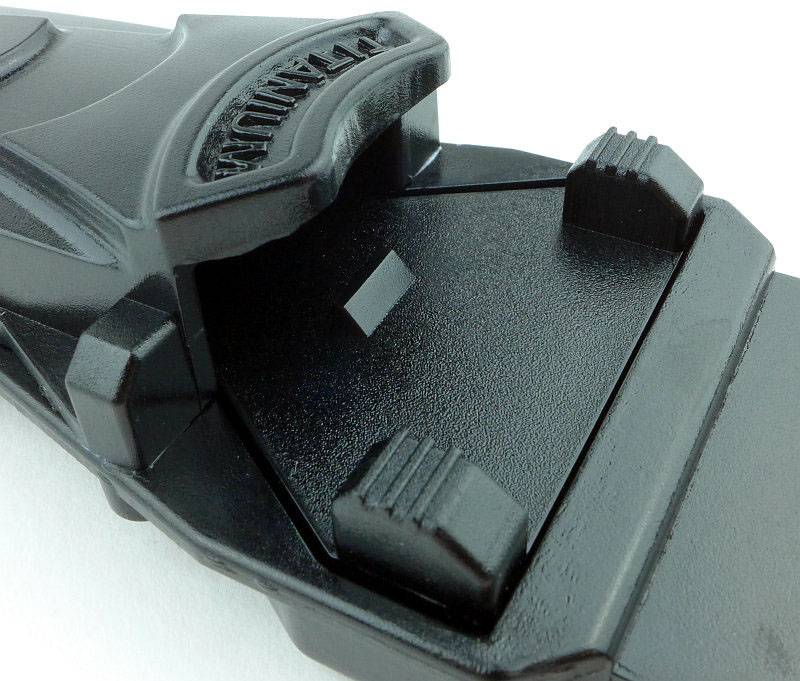
Looking at the back of the sheath, you can see the lower strap loop serves as a drainage hole. there is also a plastic spring which pushes against the blade when it is in the sheath the prevent rattling.
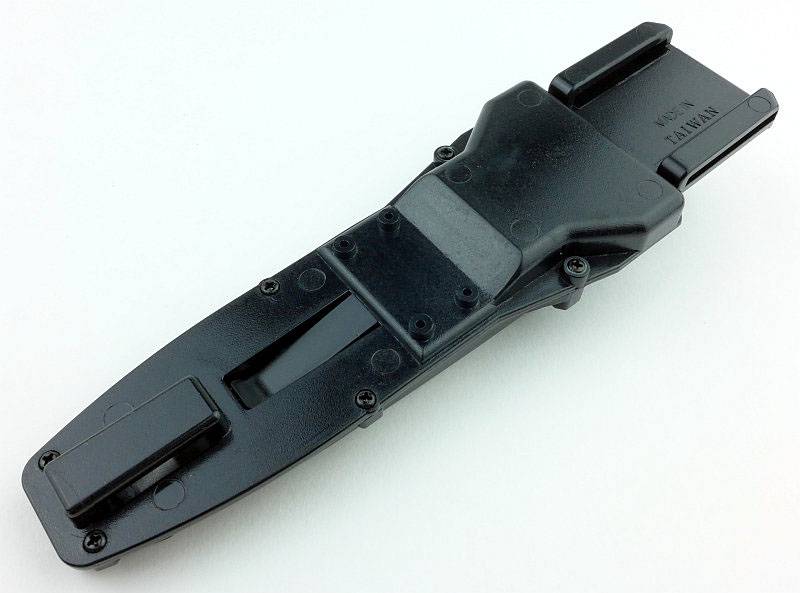
This knife has alternative colour options for the handle. The orange part of the handle can be grey or blue.
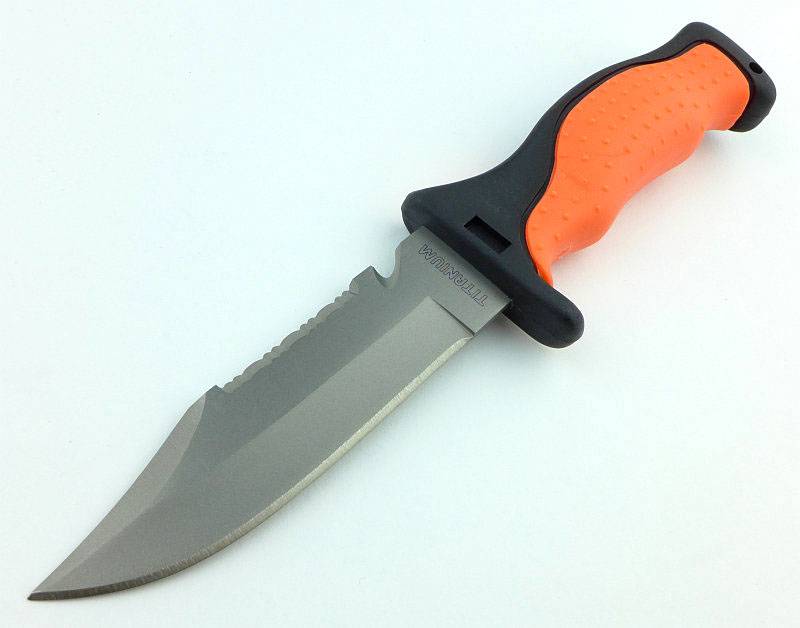
In case you forget, this is a titanium blade. Being a dive knife there is a line cutter hook.
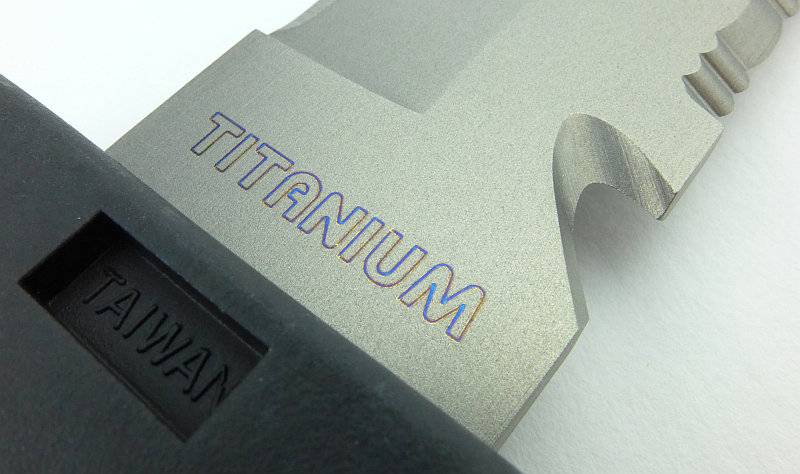
An unusual ‘reverse’ set of serrations are on the blade spine.
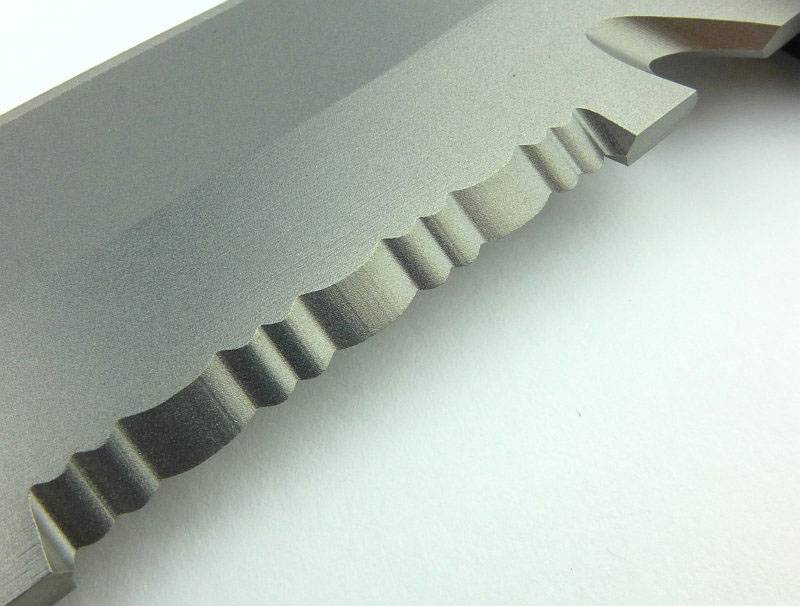
The full tang protrudes through the handle and provides a narrow hammer.
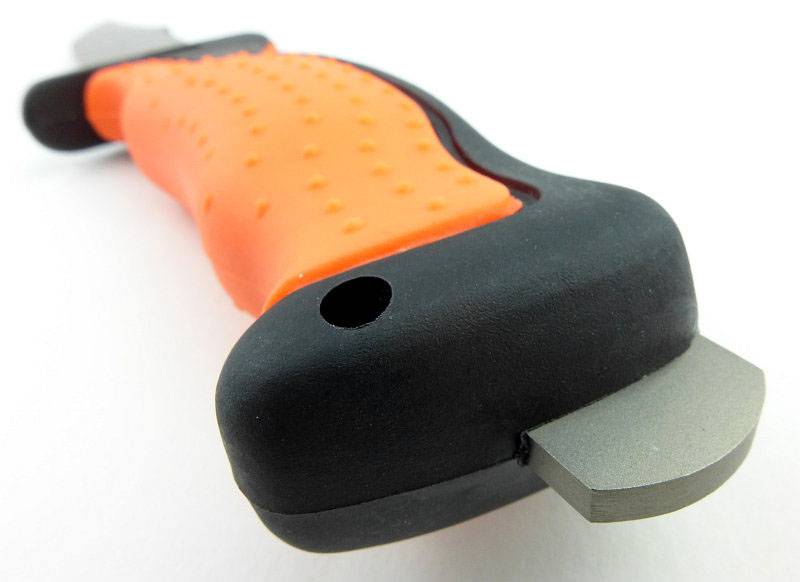
As supplied, the factor edge looks quite coarse, but cuts well enough.
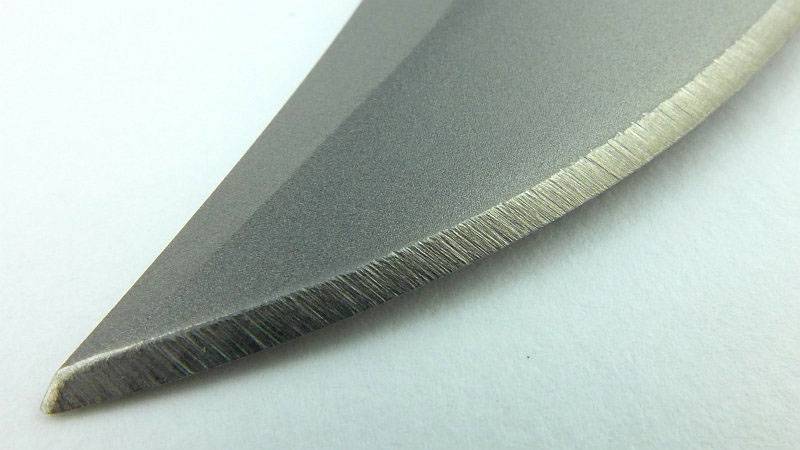
A nice mid-sized knife. (I take XL size gloves.)
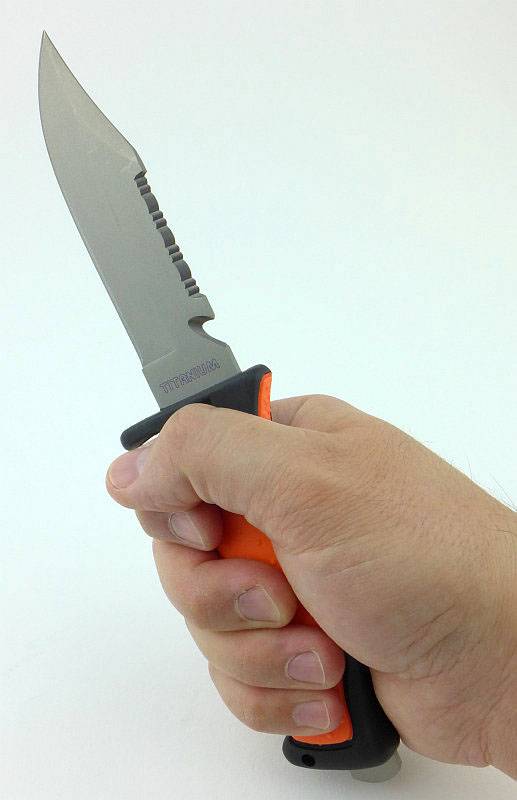
The coloured rubber insert gives a good amount of grip.
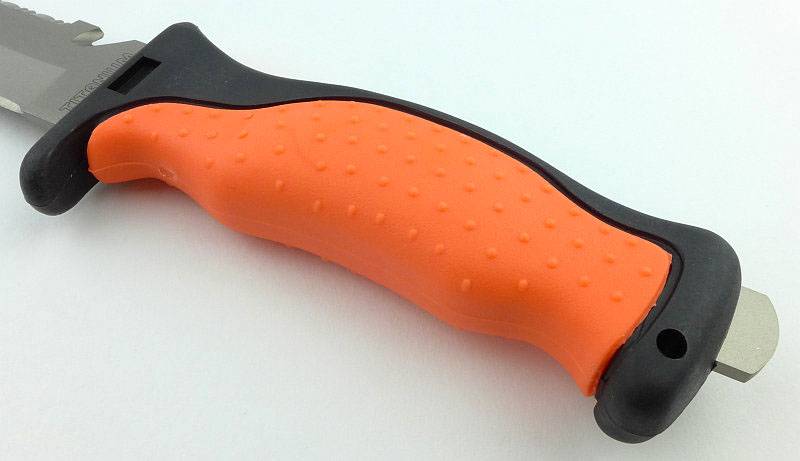
Rather than quick release buckles, this knife uses belt buckle type fastenings. Note that the holes in the strap are actually filled in. The first time you use any of them you need to push the buckle prong through the rubber in the hole.
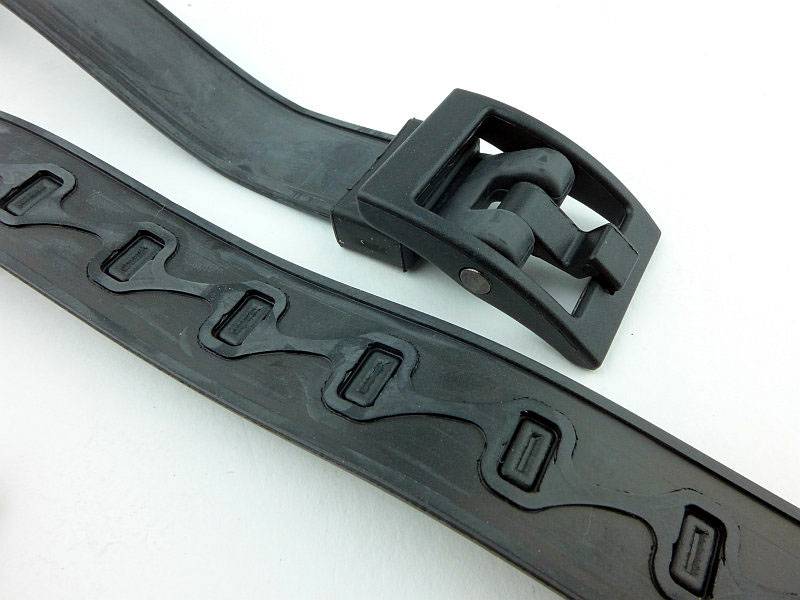
These straps are very quick and easy to set up and use.
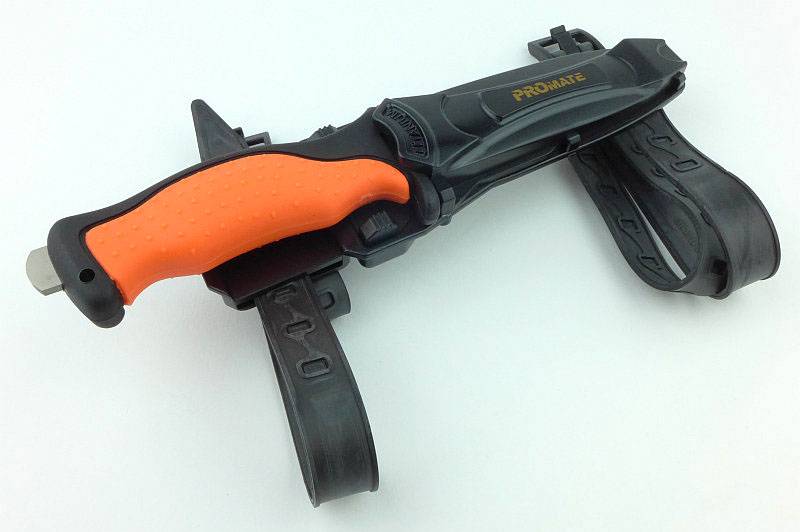
A few more details of the KF505 Blunt:
And onto the last one of the Promate knives, the steel bladed KF505.
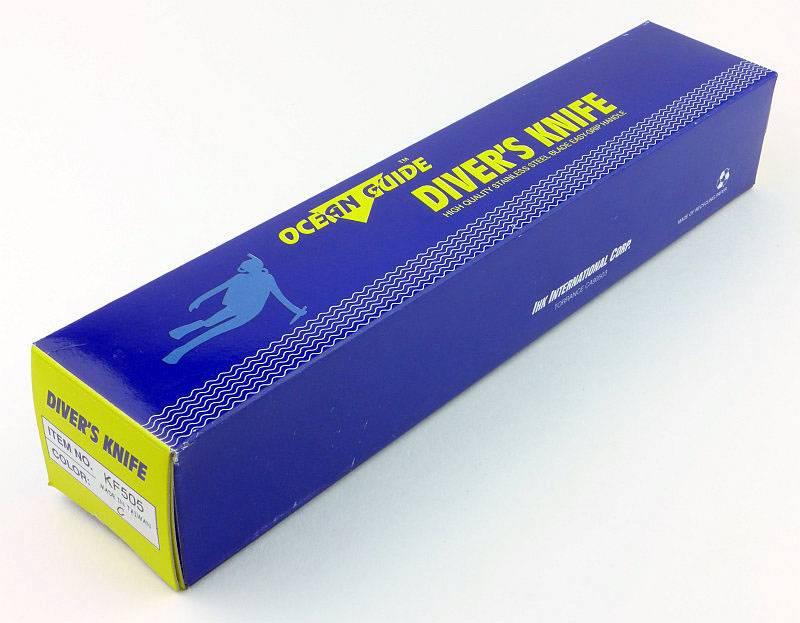
In the box is the sheathed knife, rubber straps, care instructions and disassembly instructions.
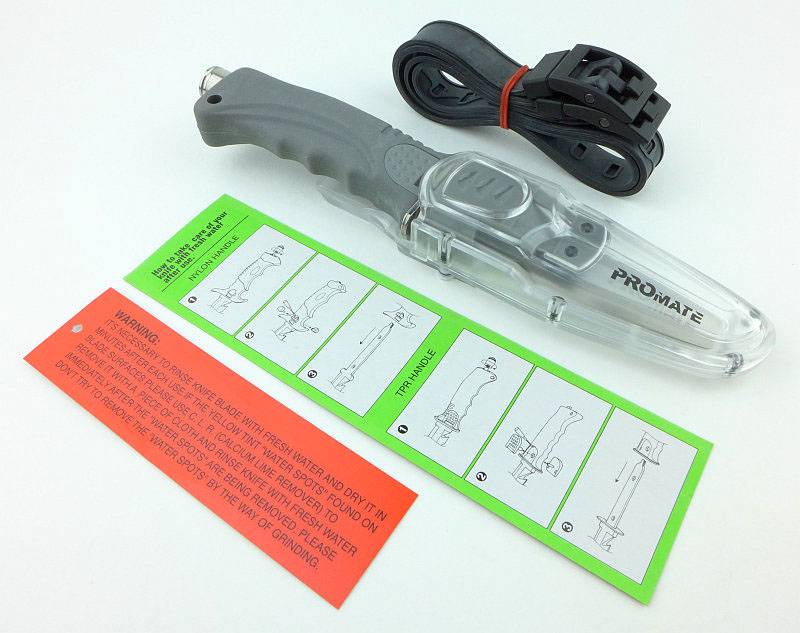
The clear sheath is an option for this knife.
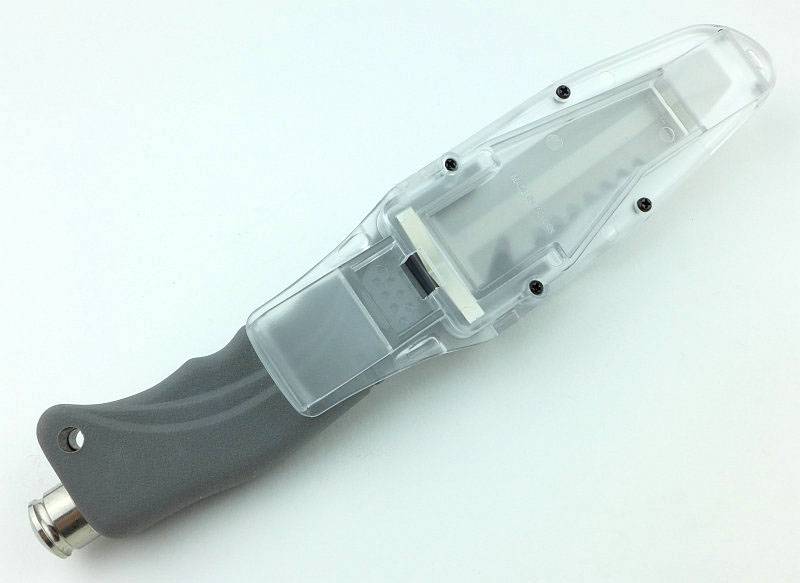
A box-fresh KF505.
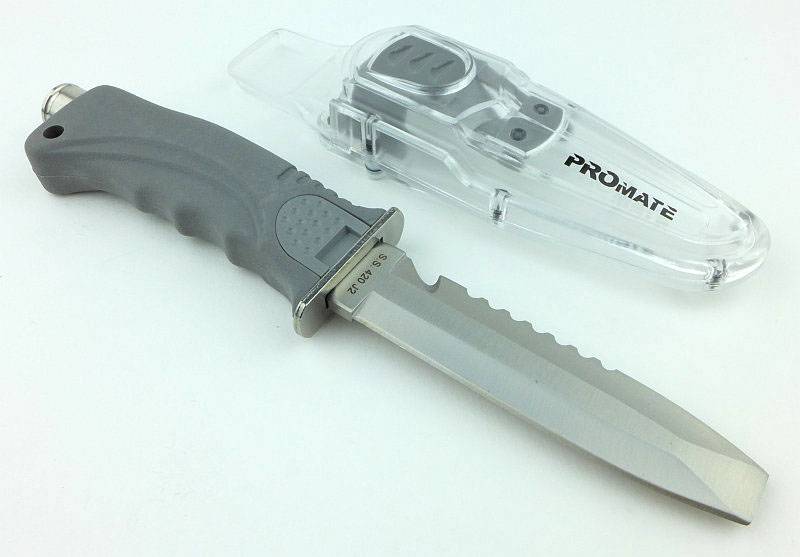
Compared to the titanium knives a different sheath retention system used. A single release button on the front of the sheath is connected to a catch at the rear.
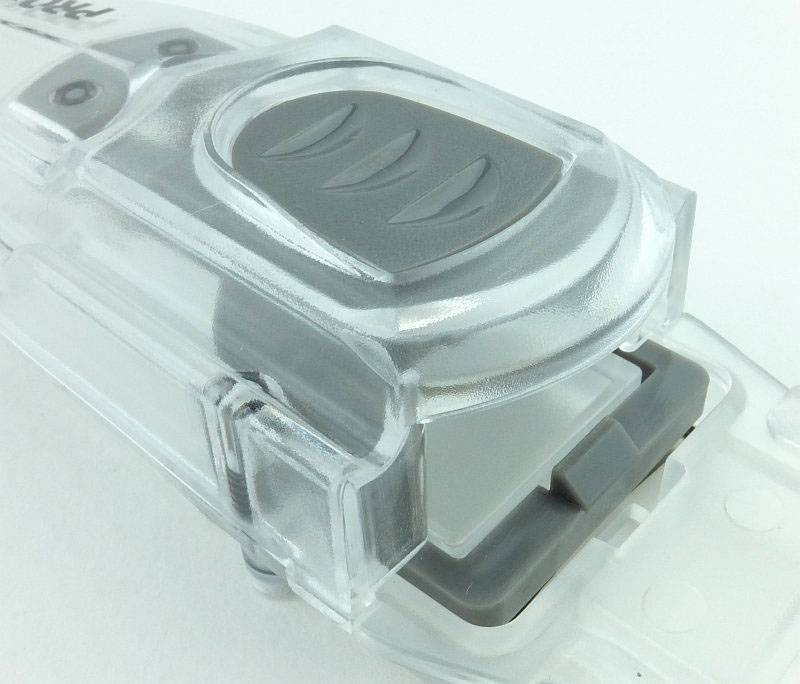
Before moving onto some details let’s look at both sides of the blade.
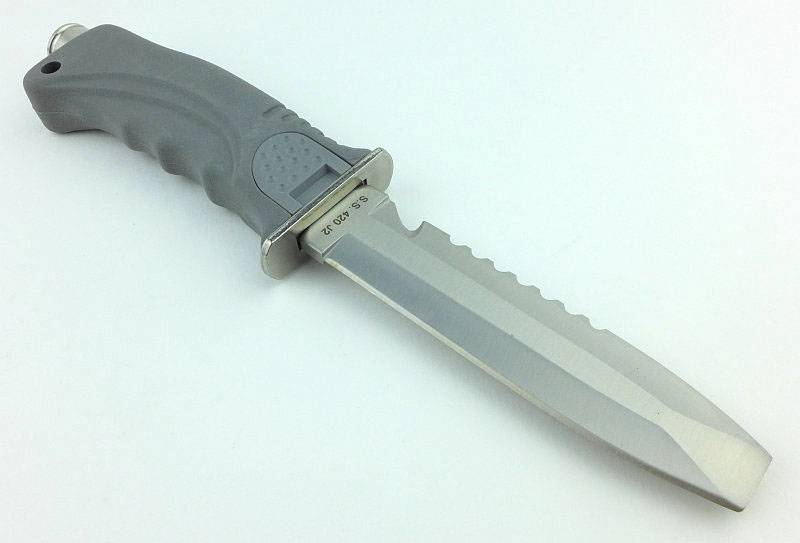
The other side of the blade.
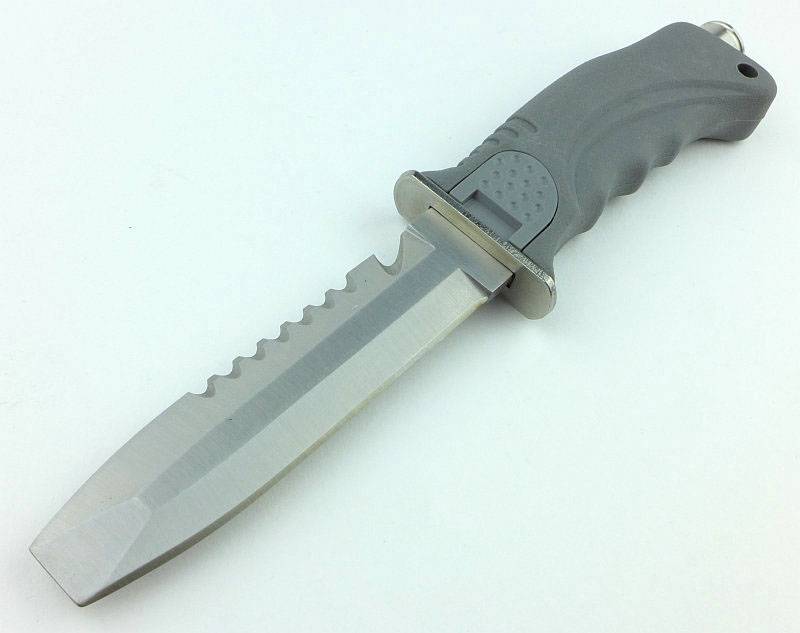
An unspecified stainless steel is used for the guard. Check the corrosion results later.
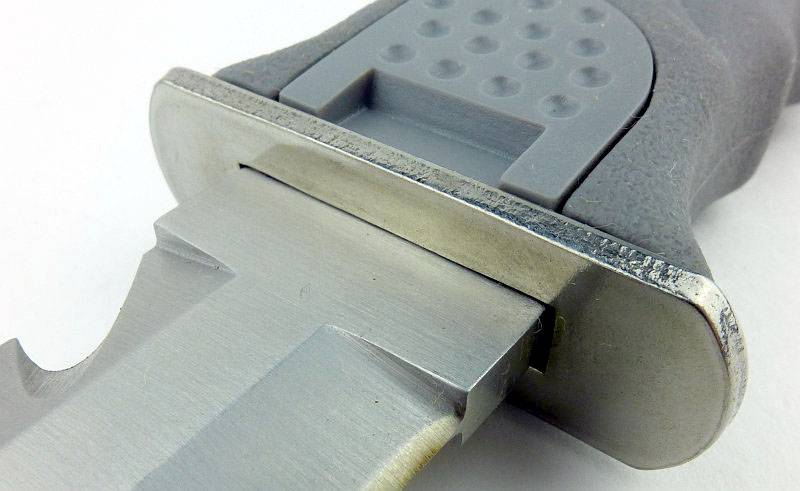
The serrations are cut with a single bevel.
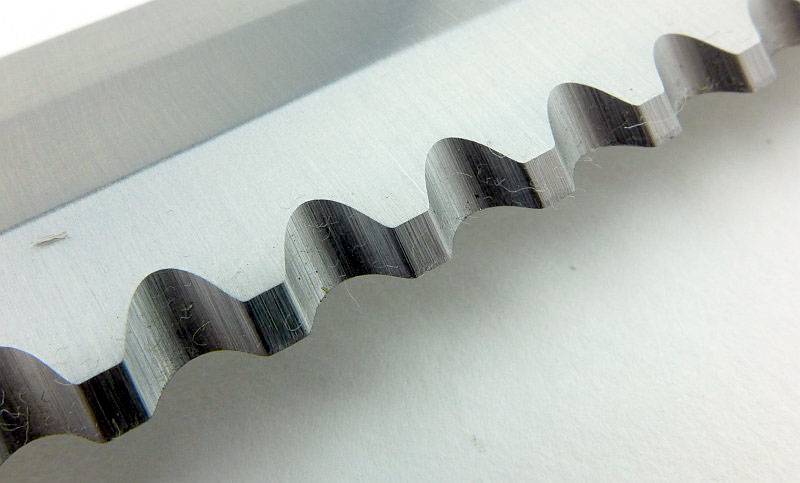
The use of a single bevel is clear when looking at the other side.
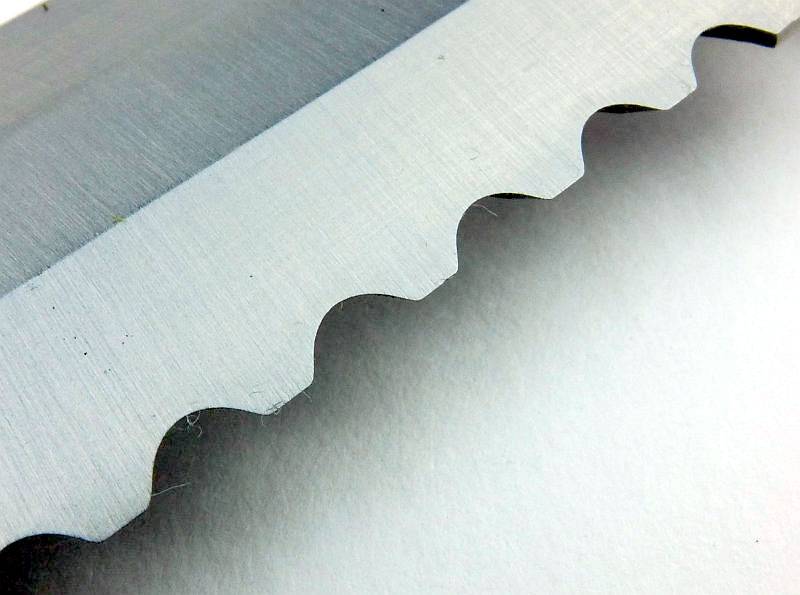
A line cutting hook is ground into the blade near the handle. Note the steel designation on the blade – Stainless Steel 420 J2.
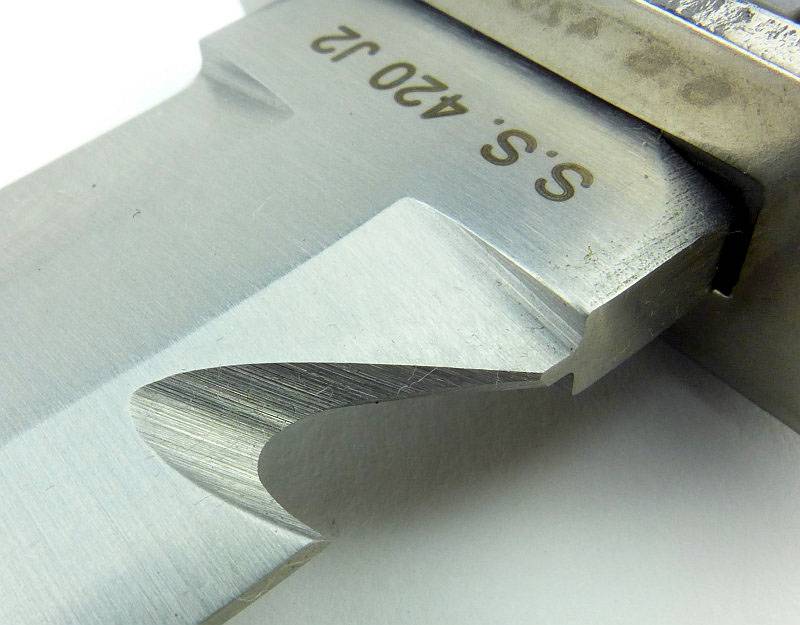
This knife uses a one-piece rubber handle.
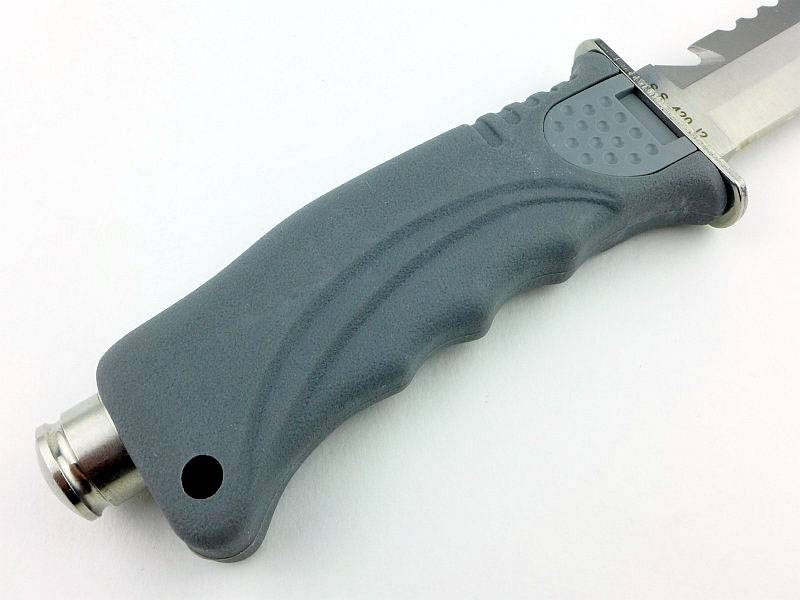
The tang nut acts as a hammer.
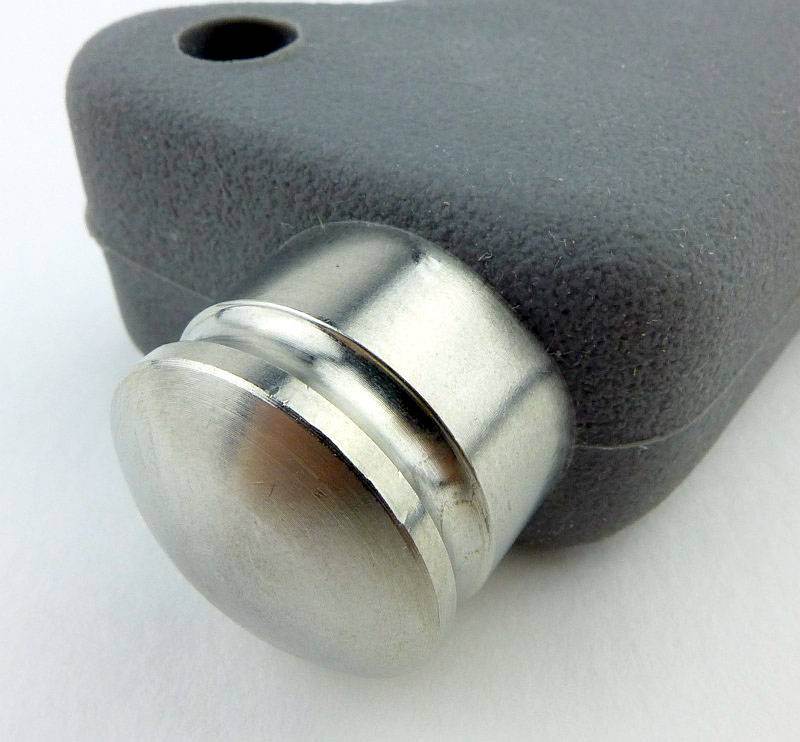
Starting to disassemble the knife by taking the tang nut off.
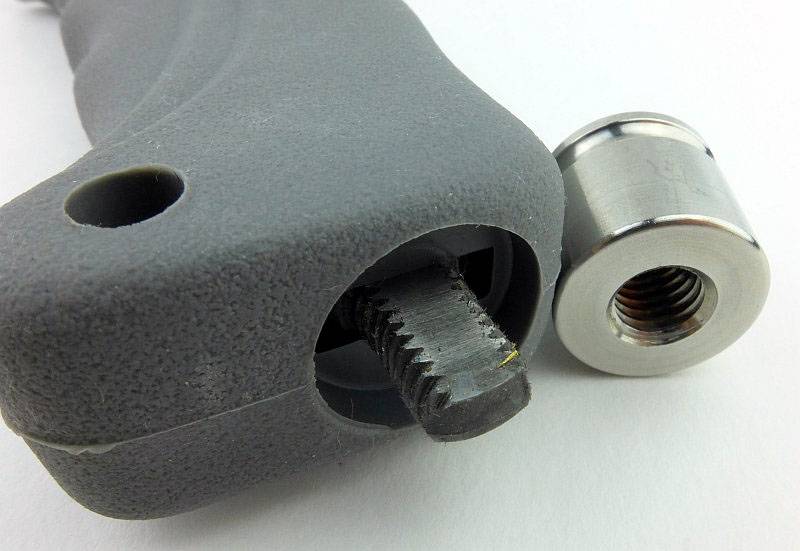
And fully disassembled.
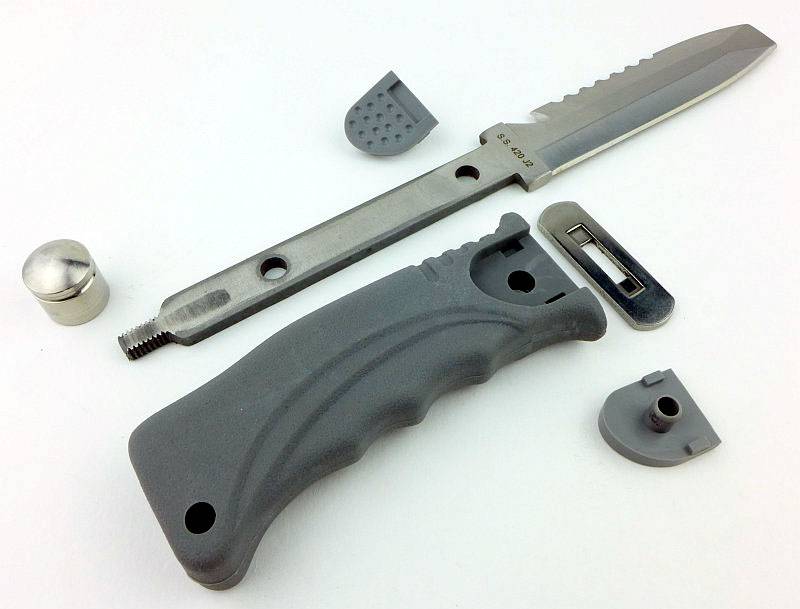
The rubber straps have standard belt buckle type fixings.
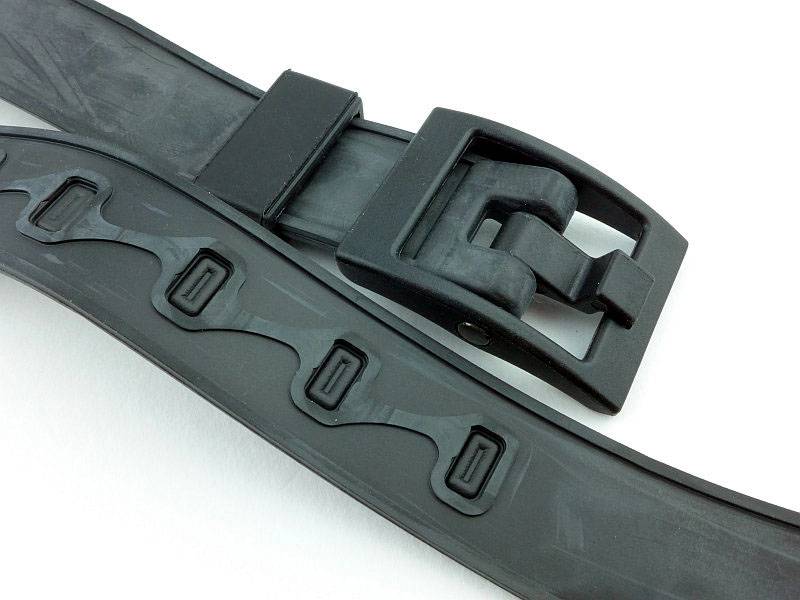
This design of strap make it very quick and easy to get everything put together ready for use.
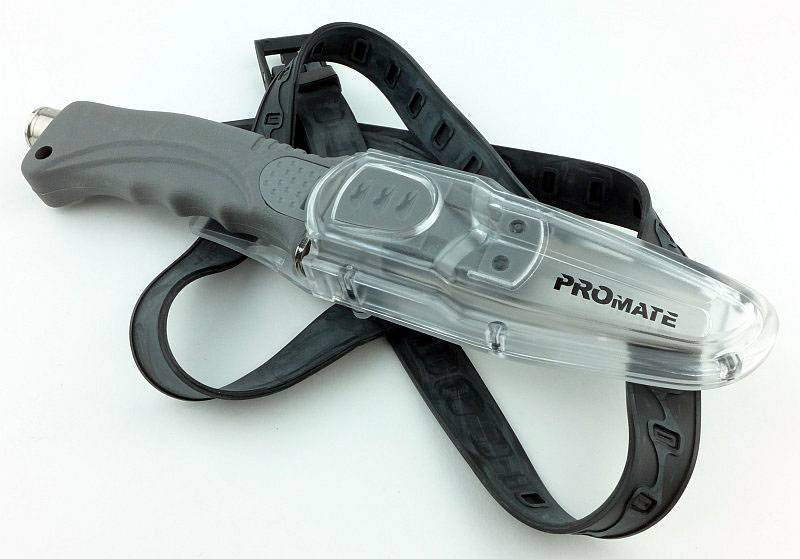
Like the previous model this is a medium sized knife.
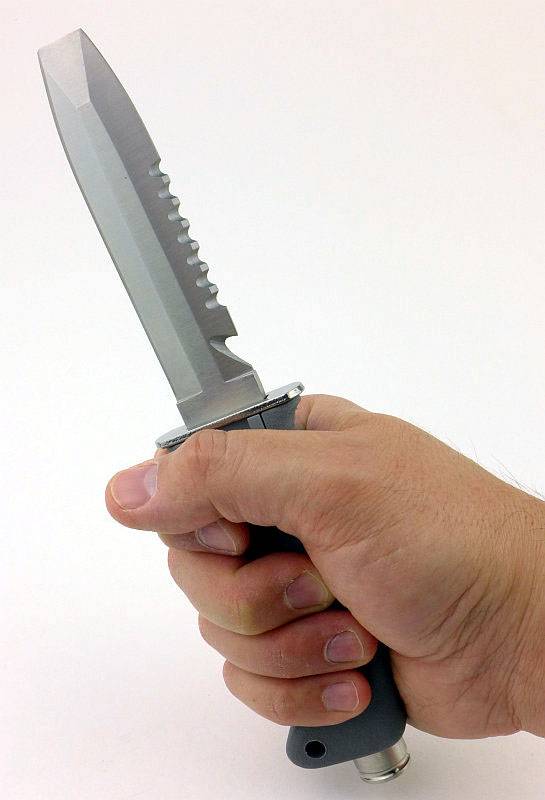
What are they like to use?
With several very different offerings from Promate, the cutting results were varied and also not as I expected. The best performer in the cutting tests was actually the Seal folder with Ti blade. This maintenance-free small titanium bladed folder makes a fantastic backup knife. The other knives were mainly let down in the cutting tests by the factory edges, and are more capable given a bit of work getting a good edge.
The biggest surprise was the performance of the dedicated line cutter; using only a standard steel utility blade as the cutting edge, the corrosion testing really took its toll on this (details to follow). With a new blade, initial tests were that this was a very good cutter, so if you can find stainless utility blades they would be a better option.
See the Dive Knives 2016 – Mega Test Review for more information on the cutting test results.
Though a really excellent cutter, the Seal knife had a small issue that was easily fixed, but one worth being aware of.
The sharp eyed might have spotted that when looking at the ‘H’ (where the blade spine and lock bar touch), the lock bar is slightly raised. This gave me concern over how well the lock would function. Proven correct, I found the lock failed under mild pressure to close the blade.
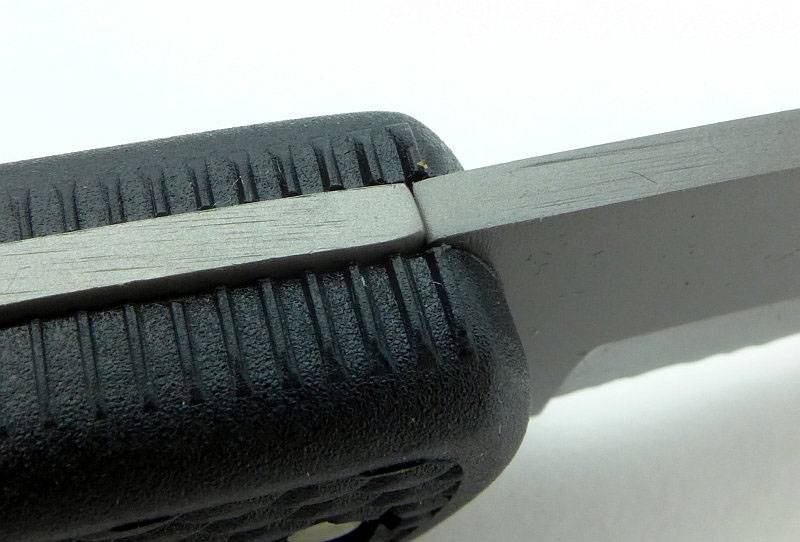
Taking a closer look at the locking surfaces, these appeared to be raw pressings so the fit was not good, and the blade tang hook was not catching the lock bar well. There is a simple fix for that….
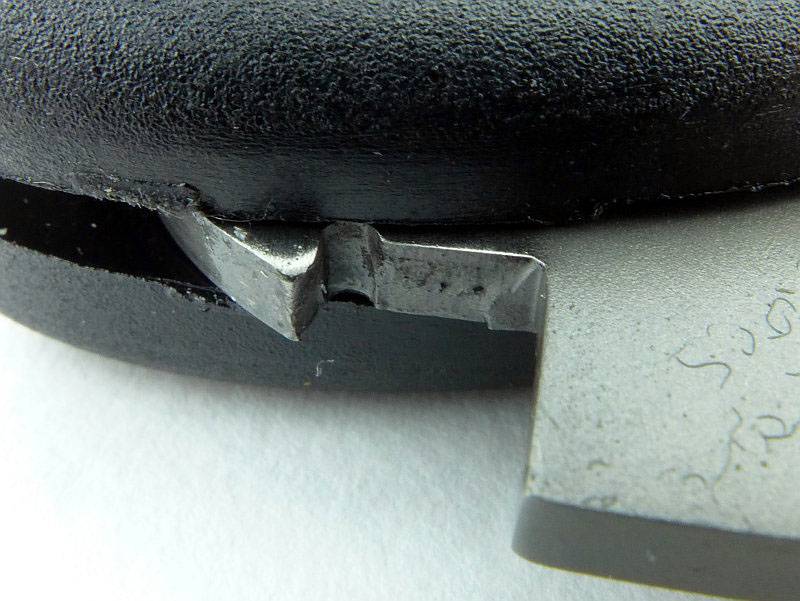
Without having to take the knife apart, the blade tang hook can be cleaned up with a file (and the Ti files easily) to give a much better flat locking surface. Be careful not to go at this too much as taking more material than necessary will result in a blade that has play in the locked position. File a bit then test, and repeat. Once corrected, the locked blade was solid and the result was worth having to do this.
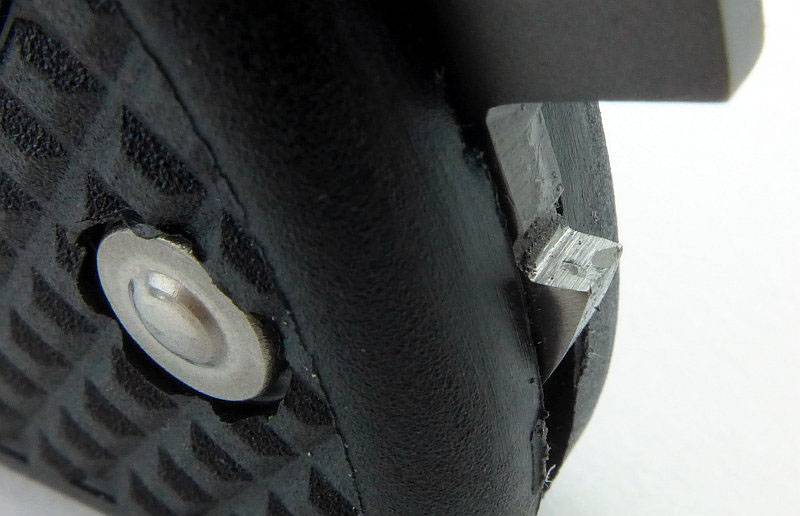
Earlier I mentioned the line cutter having disappointing cutting results, well this is why – Oh dear! The corrosion testing certainly hit the weak spot of this design – standard carbon steel blades. Cheap and easy to replace, but the rust starts as soon as it gets wet.
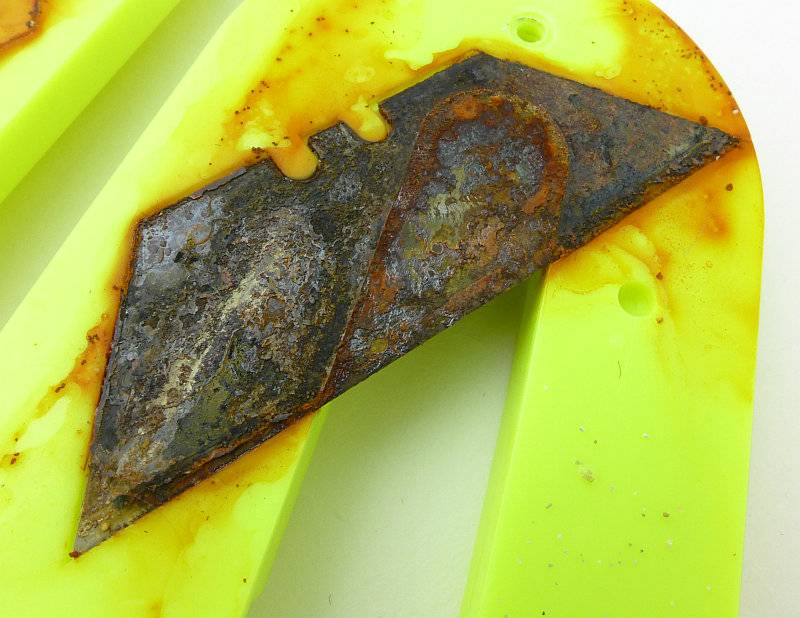
The corrosion tests threw up a surprise with the stainless steel knife. Typically, non-cutting stainless parts have a higher grade of stain resistance (with lower cutting ability), but in this case the worse corrosion was to the guard (though the hammer pommel was completely free of corrosion). The blade had a light frosting, but the guard was heavily corroded. After a cleanup, the guard was found to have deep pitting, and the clean-up (using a soak in cider vinegar) actually etched the guard heavily while making the blade nice and shiny.
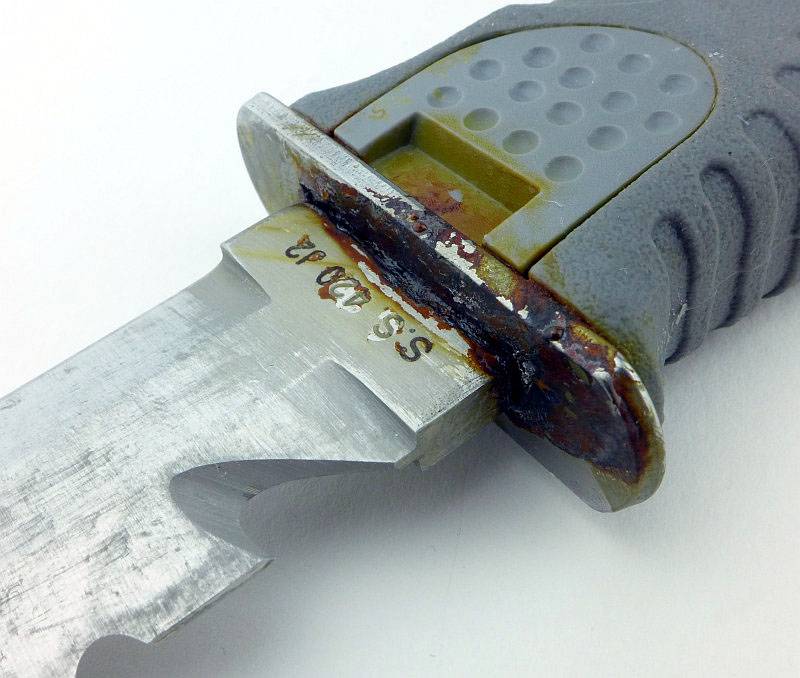
The blade itself was relatively untouched and the frosting cleaned off with vinegar.
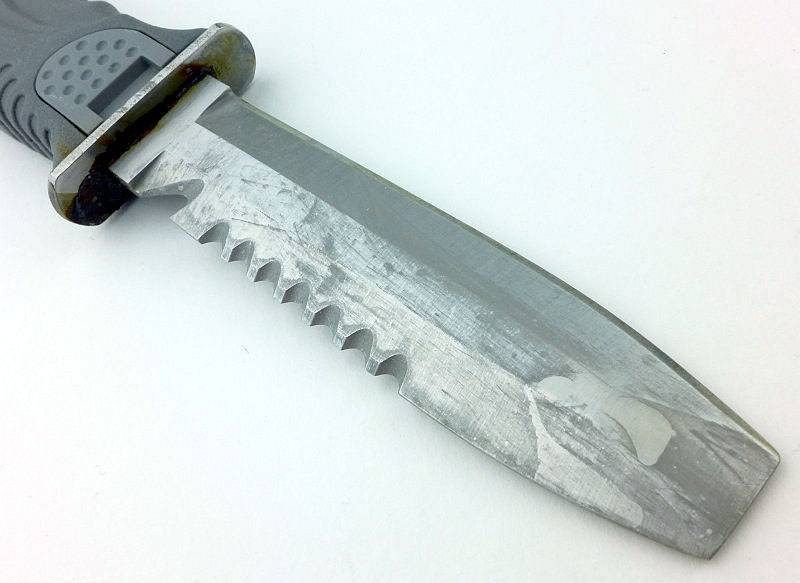
Ergonomics of the Promate knives is excellent, with easy to use, and secure, sheath retention along with great straps.
Folders are a contentious subject for diving, as the action of opening can be a make or break moment for the diver. The opening hole in the Seal folder is a little small, and being experienced in one-handed-opening (OHO) I did find this to be perfectly usable even with gloves, but with tired, cold hands and very thick gloves I suspect it will become increasingly difficult. There is also the exposed cutting hook to consider. This hook was actually a very poor cutter as it was not very sharp as supplied; with it being exposed, this lack of sharpness is actually a benefit. The Seal’s blade is worth carrying this knife for, with very good cutting ability and excellent serrations.
Overall it is clear these Promate knives are designed very well for divers, and the added bonus of zero corrosion on the titanium blades make them well worth considering.
Review Summary
The views expressed in this summary table are from the point of view of the reviewer’s personal use. I am not a member of the armed forces and cannot comment on its use beyond a cutting tool or field/hunting knife.
Something that might be a ‘pro’ for one user can be a ‘con’ for another, so the comments are categorised based on my requirements. You should consider all points and if they could be beneficial to you.
| _______________________________________________ | _______________________________________________ |
| Things I like | What doesn’t work so well for me |
| _______________________________________________ | _______________________________________________ |
| Titanium blades require no post-dive cleanup. | The steel knife and cutter suffered corrosion. |
| Excellent blade retention. | Factory edges not very good. |
| Comfortable leg straps. | Serrations are too coarse for smaller ropes. |
| Handle design provides a very secure grip. | |
| Sheaths are ambidextrous. |
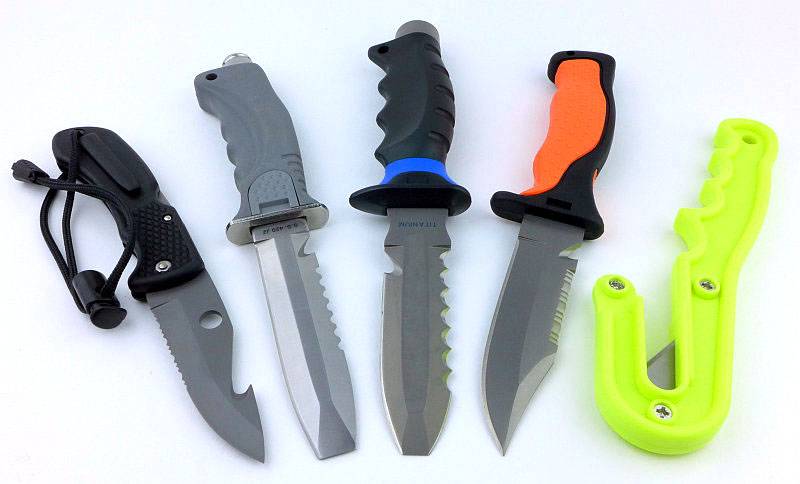
Discussing the Review:
Please feel free to add comments to the review, but the ideal place to freely discuss these reviews is on a forum. If you started reading the shorter forum version of the review, but followed the link this full exclusive review, please return to that forum to discuss the review there.
If you read the review entirely on Tactical Reviews, please consider one of the following to join in any discussion.
EdgeMatters – Sponsored Reviews (UK based Forum for Knife Makers and Collectors)
BladeForums – Knife Reviews (US based Forum for Knife Discussion)
CandlePowerForums – Knife Reviews Section (Largest and Friendliest Flashlight Community Forum)

